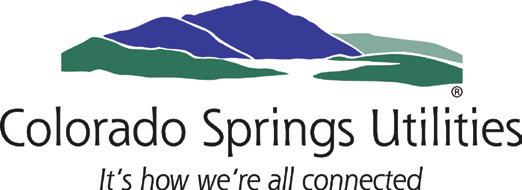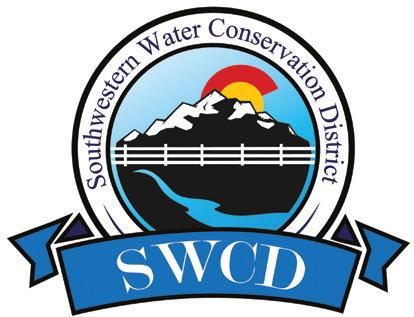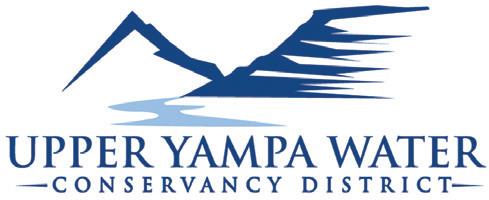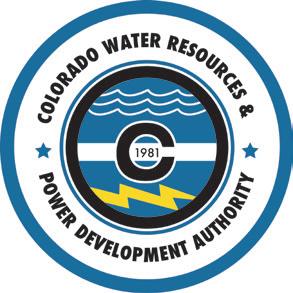COLORADO WATER CONSERVATION & EFFICIENCY

THIRD EDITION
PREPARED BY WATER EDUCATION COLORADO
COMMUNITY GUIDE TO COLORADO WATER CONSERVATION & EFFICIENCY
This Community Guide is part of Water Education Colorado’s series of educational booklets designed to provide Coloradans with factual, policy-neutral information on a variety of water resources topics. Guides in the series cover: Colorado water law, water quality protection, water conservation and efficiency, interstate compacts, water heritage, where your water comes from, transbasin diversions, groundwater, Denver Basin groundwater, and Colorado's environmental era.
View or order any of these online at www.watereducationcolorado.org.
Water Education Colorado thanks the people and organizations who assisted in the preparation and review of this guide.
Authors: Kelly Bastone, Rich Belt, Chelsea Benjamin, Perry Cabot, Caitlin Coleman, Kevin Reidy, Tom Trout
Editor: Caitlin Coleman
Design: Dana Smith
FRONT COVER: Dana Smith / AI Generated
STAFF
Juan Perez Saez
Executive Director
Sabrina Scherma
Programs Director
Saeda Aljazara
Administrative and Programs
Assistant
John Carpenter
Operations Manager
Caitlin Coleman
Publications and Digital
Resources
Managing Editor
David Grimsland
Membership and Development Manager
Tess Koskovich
Marketing, Communications and Outreach Manager
Jerd Smith
Fresh Water News Editor
BOARD OF TRUSTEES
Lisa Darling
President
Dulcinea Hanuschak
Vice President
Brian Werner
Secretary
Alan Matlosz
Treasurer
Cary Baird
Perry Cabot
Nick Colglazier
Nathan Fey
David Graf
Eric Hecox
Matt Heimerich
Julie Kallenberger
David LaFrance
Dan Luecke
Karen McCormick
Leann Noga
Peter Ortego
Nate Pearson
Dylan Roberts
Monika Rock
Ana Ruiz
Elizabeth Schoder
Don Shawcroft
Chris Treese
Katie Weeman
THE MISSION of Water Education Colorado is to promote increased understanding of water resource issues so Coloradans can make informed decisions. WEco is a non-advocacy organization committed to providing educational opportunities that consider diverse perspectives and facilitate dialogue in order to advance the conversation.
Copyright 2025 by the Colorado Foundation for Water Education DBA Water Education Colorado. (303) 377-4433 WATEREDUCATIONCOLORADO.ORG
ISBN: 979-8-9882103-2-0
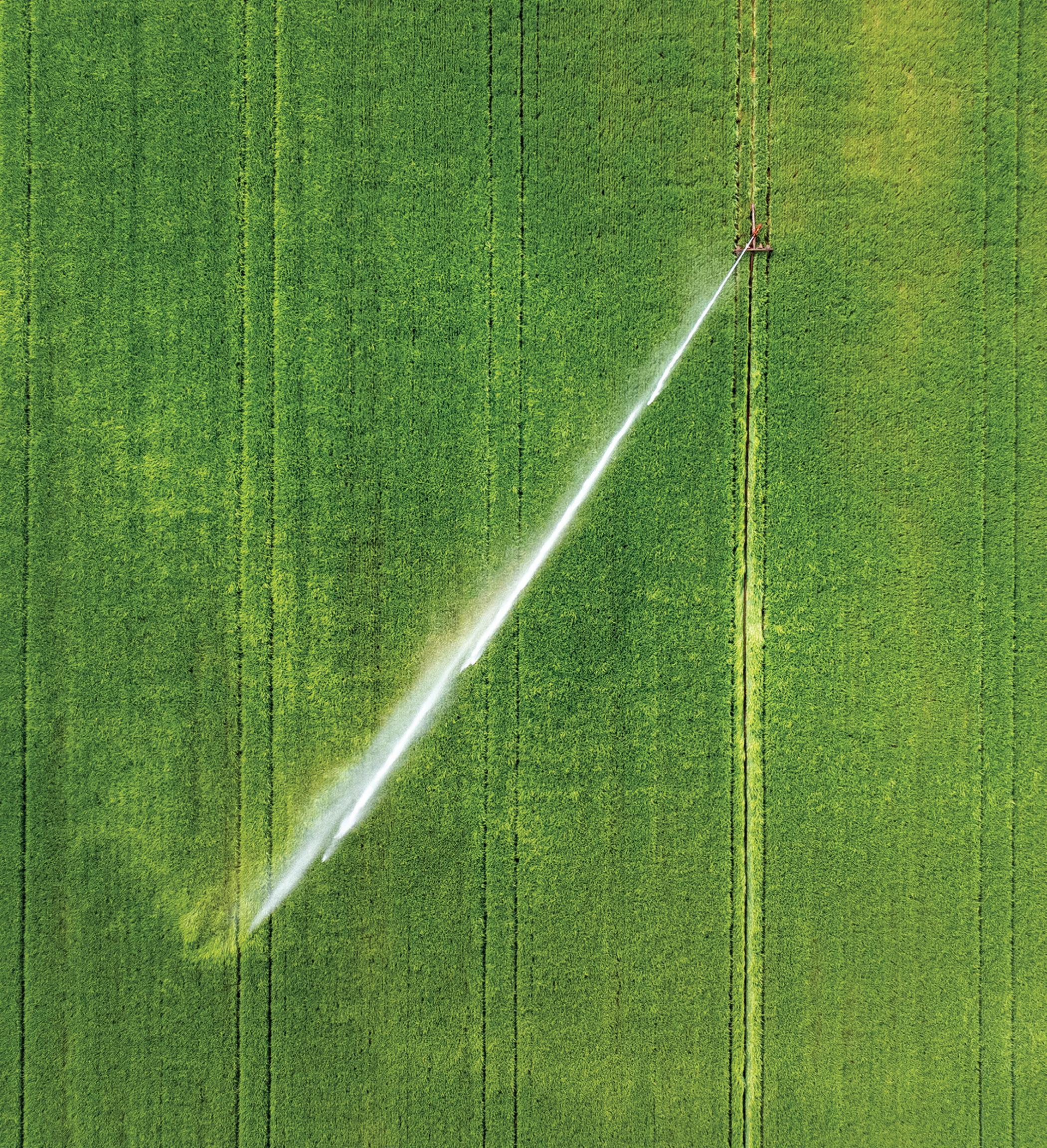
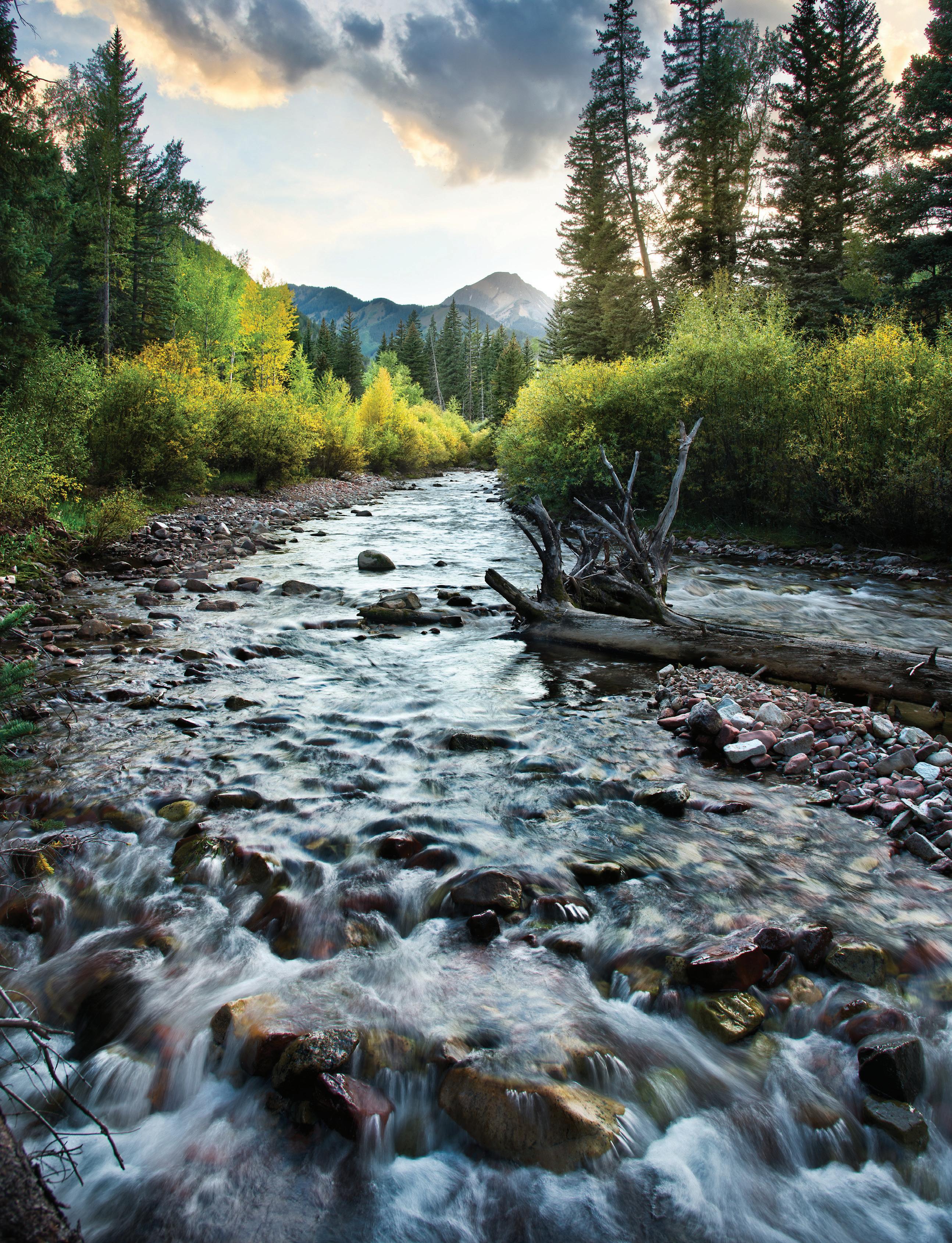
INTRODUCTION
Why Conservation & Efficiency?
Natural constraints bind Colorado’s water supplies. While water is limited, water demands are projected to grow. As demand increases, competition for water resources is intensifying, and so is the importance of efficient water use and water-conserving practices.
LIMITED SUPPLY, GROWING DEMAND
In this semi-arid state, a limited quantity of water is available each year — an amount that varies widely based on highly variable precipitation, temperature, the timing of runoff, the amount of water in underground aquifers, and the amount of surface water stored from previous years.
How Coloradans use and consume water is a reflection of our climate, topography, land use, and societal values. Water is embedded in every aspect of our lives. Individual water uses include outdoor landscaping, washing dishes, running the washing machine, toilet and shower. But our water footprint stretches well beyond those direct uses to include water used to produce the food we eat and clothes we wear, to manufacture the products we purchase, to generate the electricity we consume, to fuel our vehicles, to recreate, and more. Although much of an individual’s water footprint stems from water used outside their watershed or state, as consumers, Coloradans can look to these connections in making water-efficient choices that are beneficial for local, regional and global water consumption.
Coloradans consume an average of 5.3 million acre-feet of water per year, according to the 2023 update to the Colorado Water Plan — 90% goes to agriculture, 7% to municipalities, and 3% to industry. One acre-foot equals nearly 326,000 gallons, enough to serve two to four urban households each year. Uses in which water is not returned to the river — such as water incorporated into a manufactured product, crop evapotranspiration water, or water consumed by people or livestock — are called “consumptive uses.” Homes, business and industry, farms, recreational activities, and the environment all compete for a share of the state’s finite supplies.
But the value of water isn’t just found in consumptive water uses. Flows that remain in the river benefit fisheries, the environment, recreation, wildlife and more — they have economic value and support qualities that people love about Colorado. As competition for water intensifies, it is increasingly important to reserve water for the environment and recreation, ensuring that rivers aren't left dry.
Conservation vs. Efficiency
The terms “water conservation” and “water efficiency” are often used interchangeably but have different meanings. Conservation refers to measures that provide a verifiable reduction in the amount of water used — typically accomplished through behavior change. In agriculture, that means reducing crop consumptive use, which usually equates to less water for crops and reduced farm income. Efficiency focuses on minimizing the amount of water required to accomplish a task — often by using technology. Increased efficiency can be achieved with appliances, fixtures and sprinkler systems, or by reducing water loss and seepage.
CONSERVATION FOR THE FUTURE
While Colorado’s water supply is limited, water demands are expected to increase. Colorado’s water availability is affected by temperature and precipitation patterns which are becoming more variable and less predictable under climate change. At the same time, population has been rising. In January 2025, the Colorado Department of Local Affairs (DOLA) reported that, as of July 2023, Colorado was home to nearly 5.9 million people. DOLA projects that the population could reach 7.4 million people by 2050, with 85% of the population living along the urban Front Range.
Population growth, along with commercial and industrial growth are primary drivers of municipal water demand. The future could result in a water supply gap of 230,000 to 740,000 acre-feet per year for industrial and municipal uses, leaving many water needs unmet or met in undesirable ways, according to the water plan. In agriculture, about 20% of the demand for water is currently unmet. The need to parse scarce water supplies among so many valuable uses increases the necessity of conservation.
Agricultural: 4,844,000 acre-feet
Municipal: 380,000 acre-feet
Industrial: 116,000 acre-feet
SOURCE: COLORADO DIVISION OF WATER RESOURCES
The 2023 update to the Colorado Water Plan presents a vision and actions that Coloradans can take to address risk and prepare for a water-stressed future. Water conservation plays an important role in this future. The 2019 Technical Update to the Colorado Water Plan estimated that conservation and efficiency measures could reduce Colorado’s future water needs by 300,000 acre-feet per year.
Fully stretching limited water supplies to better meet demand has other benefits. Conservation and efficiency measures delay the capital costs of obtaining additional water, including the purchase of water rights or building larger systems for water conveyance or treatment. Conservation can also help alleviate stress on Colorado’s river systems and political stress under interstate water-sharing agreements known as compacts; demonstrate a commitment to sustainability; reduce adverse impacts of drought on farms and rural economies; and improve water quality by reducing wastewater discharges and outdoor irrigation runoff.

Homes & Cities
Homes and businesses located within towns and cities are typically served by municipal water entities. These urban and regional utilities, as well as water and sanitation districts, treat water to make it fit for drinking and deliver it to residential and commercial buildings, parks, open space and more. Municipal water use represents 7% of Colorado’s total water consumption, according to the Colorado Water Conservation Board.
Treated, potable water is used primarily for drinking, sanitation and landscape irrigation, along with public functions such as fire protection, swimming pools, golf courses, and parks. In some communities, water is recycled and treated to a lesser extent than drinking water. Non-potable water is not fit for human consumption but can be applied to other outdoor or industrial uses.
Between 2000 and 2015, Colorado’s per-capita water use decreased by 20% statewide, with some municipalities reducing per-capita use by as much as 30%. These reductions in residential and municipal water use are attributable to a number of factors. For one, Colorado’s urban landscape has changed. Today, the state’s metropolitan areas include many more water-wise and native plantings and less turf grass. That transformation is ongoing, with recent legislation passed — including HB22-1151, SB24-005 and HB251113 — to fund turf replacement efforts and to prohibit the installation of non-functional turf in certain institutional, commercial and industrial properties. Additionally, statewide legislative mandates for WaterSense fixtures — including SB14-103, HB19-1231 and HB231161 — have helped reduce water use by ensuring that new fixtures and irrigation controllers sold in the state use water efficiently and meet performance standard criteria. Redevelopment has also led to more dense urban spaces, with less outdoor space to irrigate and new efficient water fixtures built in.
The 2015 Colorado Water Plan set a statewide goal of conserving 400,000 additional acre-feet of municipal water by 2050. The 2023 update to the water plan established action items that are less quantifiable. The 2023 Colorado Water Plan looked at a range of future scenarios and projected a gap between the amount of water available for municipal uses and the amount of water needed for those uses between 230,000 acre-feet and 740,000 acre-feet per year. To address that gap, the plan called for the creation of a template that defines what a water-saving community looks like and identifies conservation benchmarks that communities can aim for. The plan also emphasized the need to track water losses across municipal systems, and to improve the way that water use and efficiency data is collected and stored so that the resulting database can help improve future conservation and drought planning efforts. It suggests expanding water reuse, promoting OneWater strategies for integrating water and land use planning, and focusing on turf replacement.
In municipalities, water conservation efforts aim to minimize water loss or waste across water systems and in homes and businesses. This may be achieved in water supply systems through leak detection, rapid response and repair, and systematic annual water loss audits. In homes and businesses, conservation can be accomplished through well-designed outdoor irrigation systems that use and waste less water, by installing landscaping that requires less water, and via zoning and laws or policies that encourage efficiency from the start. Water efficiency refers to technologies and policies
that facilitate using less water to accomplish an activity. Efficiency in homes and cities can be achieved through items such as high efficiency toilets and showerheads, high-efficiency clothes washers, and drip irrigation systems.
The success of water efficiency and conservation initiatives for homes and businesses depends largely on people’s attitudes toward conservation, their understanding of how to reduce water use, changing social norms, and the availability of incentives and technology to do so.
RESIDENTIAL WATER USE
During Colorado’s summer months, the majority of water delivered to residences is applied outside to lawns, trees and gardens. Historically, landscape irrigation accounted for more than half of annual domestic water use in Colorado. According to the Colorado Water Conservation Board, this changed between 2006 and 2016 and household water use moved toward a division of 60% indoor use and 40% outdoor use.
By The Numbers
Average number of gallons that Coloradans use per capita per day for municipal purposes
Per-capita water use in Colorado varies widely by locale, and with municipalities serving both commercial and residential customers, it can be difficult to separate out residential use. Because the specific climate and mix of residential and commercial uses in communities can dramatically affect water use when measured system-wide, per-capita water use isn’t necessarily the most useful measure for drawing comparisons. However, it can be used to identify long-term trends.
The latest data from the Colorado Water Conservation Board indicates that statewide and systemwide, Coloradans are using 164 gallons per capita per day (GPCD). That can be compared to the national average of 82 GPCD, per U.S. Geological Survey (USGS) data; however, the USGS calculation only includes domestic water use. Higher than average water use in Colorado can be attributed to low precipitation rates, the need to irrigate gardens and lawns during the growing season, and the custom of planting landscapes typical of more water-rich regions.
Colorado is making strides in reducing its per-capita water use, thanks to more state and local regulation, conservation programs, increasing water rates and conservation pricing, financial incentives
offered by utilities and municipalities, and changing norms as Coloradans become more aware and more willing to conserve. Many communities have formalized conservation plans and have improved those plans over the past 30 years or so. For example, Castle Rock, which has reduced its municipal water use by 20% in recent years, formulated its Water Use Management Plan to outline irrigation schedules, rainwater collection policies, landscape codes and other regulations and expectations regarding municipal water use.
MUNICIPAL WATER CONSERVATION ACHIEVEMENTS
Communities across Colorado have made significant reductions to their per-capita water use since 2000, even as populations have grown. Aurora Water and Denver Water both reduced their residential gallons per capita per day (R-GPCD) by 36% between 2000 and 2020, according to the 2022 Memorandum of Understanding by and among Colorado River Basin Municipal and Public Water Providers. And a study published by Brian D. Richter in the 2023 Journal of Water Resources Planning and Management revealed that between 2000 and 2020, the Ute Water Conservancy District, which serves Grand Junction, reduced its R-GPCD by 20%, while Fort Collins Utilities reduced its R-GPCD by 43%. During the same period, Colorado Springs Utilities reduced its R-GPCD by 41%.
When municipalities are confronted with the reality of potential supply shortages as in a drought, they turn to outdoor watering restrictions, public education campaigns, and other tools to encourage conservation. A 2004 paper, “Use and Effectiveness of Municipal Water Restrictions During Drought in Colorado,” found that mandatory water use restrictions in 2002 in select Colorado cities reduced per-capita use by 15% to 55%. Many of those watersaving strategies have become normalized, particularly with outdoor water use. Some water utilities have adopted permanent watering restrictions to reduce outdoor water use.
The 2019 Technical Update to the Colorado Water Plan reports that outdoor efficiency programs often save between 20%-30%, some achieving savings of over 50%. Because of reduced outdoor irrigation, steep cuts in water use achieved during previous times of drought may be hard to replicate in the future. Colorado Springs, for example, used to experience a 30% reduction in summer use when it instituted a two-day limit on outdoor watering during dry years. Now, people are using less water on their landscapes overall due to efficiency programs and are seeing 15% reductions when drought restrictions are implemented.
Nevertheless, drought response measures can significantly lower demand temporarily, potentially leading to new, longterm conservation habits. However, drought response does not necessarily equate to long-term conservation. The 2010 “SWSI Conservation Levels Analysis Final Report” prepared by the Great Western Institute for the Colorado Water Conservation Board shows a dramatic 22% dip in per-capita water use from 2000 to 2003 as a result of the drought. Between 2003 and 2010, some of that reduction wore off, but 15% of that 22% water savings were retained, with water use never climbing entirely back to pre-drought levels. Drought response can have a lasting impact on water demand. Still, the continued success of efforts to reduce urban water use largely depends on long-term incentive and customer feedback programs
designed to change public values and behaviors, coupled with the implementation of more water-efficient technologies.
INDOOR WATER USE
The statewide average for daily per-capita indoor water use was 51.8 gallons as of 2019, according to the 2019 Analysis and Technical Update to the Colorado Water Plan. Indoor use continues to decline, with many communities moving toward 35 GPCD or lower. Water conservation has been bolstered by federal and state efficiency standards, along with increasing public awareness. A 2021 survey conducted by the Colorado Water Conservation Board with BBC Consulting found that Coloradans understand the connection between their water use and the larger issues of water scarcity and drought. This awareness is an important driver in reducing personal use. Water rates across Colorado have also increased — that increase has reduced water use.
Water-efficient plumbing fixtures, high-efficiency appliances and home leak detection devices are the main technologies available to consumers to reduce indoor water use, while advanced metering infrastructure (AMI), including smart metering, and water audits can be made available by water providers to help consumers make informed water use decisions.
Water savings occur both passively and actively. “Passive” savings result from factors beyond the purview of a utility’s conservation program — typically through housing and business retrofits mandated by law. A 2015 study by Aquacraft estimated that over 40% of the water supply gap that municipal and industrial water users face could be met with the passive replacement of interior retrofits and strict building codes that require use of the most efficient fixtures.
“Active” water savings result from proactive conservation efforts where a water provider spends time and money purposefully encouraging conservation that requires a customer’s participation and response. This can occur through rebates, audits, leak detection, education and outreach to facilitate awareness and behavior change, conservation rate-setting, and more.
OUTDOOR WATER USE
Urban lawn watering is the single largest demand category on Colorado’s municipal water supplies. According to a 2023 report by BBC Research and Consulting, outdoor irrigation accounts for 40% of Colorado’s municipal water use. That percentage varies regionally: BBC Research and Consulting estimated that some 70% of municipal and industrial outdoor water use occurs in the South Platte Basin, 18% occurs in the Arkansas Basin, and the remaining 11% occurs across the rest of Colorado.
Although they can be water intensive, urban landscapes are essential. Green spaces can cleanse our water, reduce stormwater runoff and flooding, and keep pollutants out of groundwater. Trees, grass and other landscaping mitigate rising temperatures, improve air quality, and provide a place for pollinators. Gardening is one of the most popular hobbies in the United States, with 55% of households participating in 2023, according to a report by Bigger Garden. Gardens are aesthetically pleasing and they also serve as a place of refuge for many, providing both mental and physical health benefits.
To maintain and benefit from our urban landscaping, while also being cognizant of water’s scarcity, outdoor efficiency improvements are among the most important municipal water conservation efforts in Colorado. Designing a water-wise or native landscape right from the start, reducing high-water use areas, installing waterefficient irrigation including drip irrigation, proper scheduling, and maintenance can significantly reduce the demand for outdoor water use without sacrificing attractive landscapes. The water savings achievable with well-designed, installed and maintained landscapes and irrigation systems varies depending on the irrigators' behaviors and how much they were watering prior to those improvements. A person who was historically overwatering could cut their water use in half with a well-designed landscape, appropriate irrigation practices, and updated irrigation system. Another who was underwatering would make the same improvements but see an increase in water use and a healthier landscape as a result of irrigating sufficiently to meet their landscape’s needs.
Generally, household irrigation efficiency depends on the irrigation system’s ability to deliver the optimal amount of water required by each area of a landscape while minimizing waste. Sometimes the most water-efficient systems involve more than one type of irrigation — pop-up sprinklers with rotary nozzles may be best for turf, while drip irrigation may be more appropriate for areas containing flowers or shrubs. Regardless of the irrigation technology or plant material, human behavior and the ability of the user to effectively use that technology will remain the most critical factors affecting landscape irrigation efficiency.
PRACTICES FOR OUTDOOR WATER CONSERVATION AND EFFICIENCY
1.
Landscape Design, Installation and Maintenance
The 2024 Colorado WaterWise Best Practices Guidebook recommends considering slope, existing plants to preserve, exposure to natural and human elements, soil conditions, stormwater implications, hydrozoning — or grouping plants according to their water needs and designing irrigation systems to meet those needs — and meeting applicable landscape standards when designing a landscape. During installation, WaterWise recommends mulching to reduce evaporation, understanding soil conditions, and more. Finally, maintenance practices preserve ongoing water savings. These include maintaining the irrigation system, aerating turf in the spring and fall, weeding to maintain landscape health, and more.
2 . Landscape Water Budgets
Landscape water budgets are a proven conservation tool that water districts across the West have begun to adopt to help users understand what qualifies as “reasonable” water use and how their habits compare to broader norms. Sometimes water budgets are tied to water rates — Boulder, Greeley, Centennial and Castle Rock, for example, use a tiered rate structure that charges more for water when users exceed projected norms. Water budgets are also used informationally without a connection to the water rate structure as with Denver Water.
Each water budget is typically customized to an individual property. Indoor water budgets are best calculated based on number of residents and an efficient level of indoor use. Outdoor water budgets are based on the landscape size and the plants' climate-
Top 10 Ways To Save Water...
INDOORS
Use WaterSense for high-efficiency fixtures: Install ultra high-efficiency aerators on faucets and ultra-highefficiency showerheads instead of conventional ones to save up to 2.5 gallons per minute. Look for efficient fixtures, including toilets. The average family can reduce water used for toilets by 20-60%.
Fix the leaks: Faucet and toilet leaks lead to a lot of lost water — 7 gallons per day for a faucet and 200 gallons for a toilet.
Make appliances do the dirty work: Use the dishwasher and washing machine instead of handwashing, and run appliances only when full. You can save anywhere from 15-30 gallons per load by filling up and cutting a load.
Toss, don't flush, trash and wipes! Put waste like tissues and other items in the trash rather than flushing down the toilet. Never flush wipes, even if they say "flushable," which can block sewer pipes. Every flush avoided saves about 1.5 gallons.
Lessen up while you freshen up: Turn off the water while brushing your teeth or while shaving/ soaping up for the shower. Go the extra step and take the 5-minute shower challenge! Every minute with the faucet off saves at least 2 gallons of water!
OUTDOORS
Go native and adaptive to limit turf in landscapes: Reduce or omit thirsty bluegrass and replace with ColoradoScaped native, drought-tolerant plants and flowers. For any remaining turf, keep blades at least 3" tall to retain moisture.
Be sprinkler smart: Install efficient sprinkler systems like drip irrigation, rotary nozzles and smart irrigation controllers, and program to water only at dawn and dusk and no more than three days per week. Then, maintain by repairing broken sprinkler heads and changing program settings seasonally as water demands diminish.
When it rains, use it! Skip watering if it recently rained or rain is in the forecast — a smart irrigation controller or rain sensor can help. Direct downspouts to garden areas, not sidewalks or streets, and use rain barrels to capture rainfall for later use on plants and flowers.
Sweep, don't spray: Use a broom, not a hose, to clear debris from sidewalks and driveways.
Use your voice: Talk to your property manager or HOA about smart outdoor watering practices. And anyone can encourage local officials and utilities to improve water conservation in their town or city.
Conservation and One Water
A growing number of communities across Colorado and the nation are embracing the One Water movement, which started in the early 2000s as an effort to increase efficiency between stormwater, wastewater and drinking water utilities. Today, the One Water paradigm considers much more: Environmental conservation, land use and development, even social justice all factor into the One Water ethos that views water holistically — and recognizes that it is a limited resource.
In Colorado, Denver became the first community to formally commit to One Water strategies in September 2021, when it released its One Water plan. Like other One Water plans from large U.S. cities, Denver’s vision taps a diverse set of stakeholders — from utilities and flood control districts to city planning departments and environmentalists — to collaborate on projects and programs that manage water for multiple benefits. Denver’s 39th Avenue Greenway project exemplifies One Water’s multi-benefit approach: That installation controls
flooding, filters stormwater to improve water quality and cleanliness, and provides recreational amenities for traditionally underserved residents. By stretching existing water resources and increasing efficiency across water users, One Water principles can improve communities’ water conservation.
Consequently, the 2023 Colorado Water Plan calls for cities across Colorado to do as Denver did and embrace One Water planning and approaches. Through its Colorado Water Plan Grant Program, the Colorado Water Conservation Board funds pilot projects that explore water reuse, landscape transformation, water supply study, and other initiatives that squeeze maximum service out of one limited resource.
With One Water, all stages of the urban water cycle are considered, with an eye toward integrating and capitalizing on their potential benefits. Here, precipitation is treated for use. Some of that water becomes wastewater, which is reclaimed for additional use. Stormwater is treated as a resource.
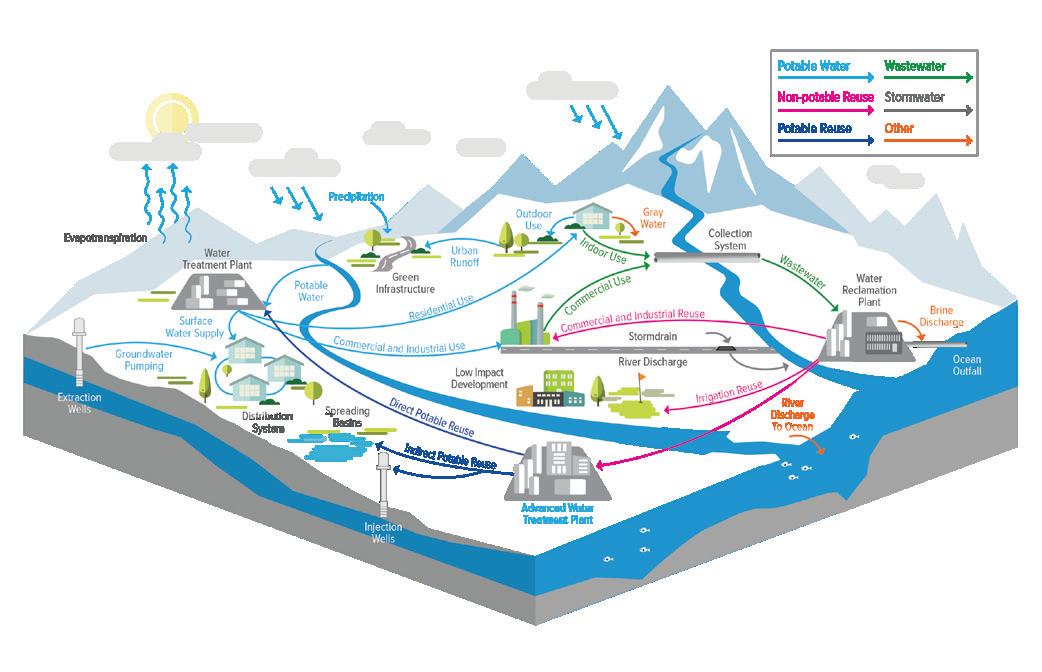
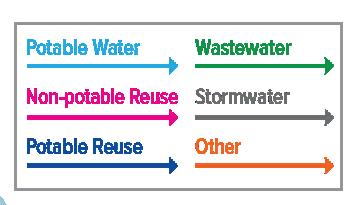
adjusted water requirements. A landscape water budget can be used to compare metered consumption against the reasonable outdoor water needs of the customer.
After implementing budget-based rates, the Centennial Water and Sanitation District reported a 25% reduction in demand, which can be tied to reductions in landscape water use, according to the 2010 Colorado WaterWise “Guidebook of Best Practices for Municipal Water Conservation in Colorado.”
Water budgets can help users better understand if their consumption is reasonable or not and to make informed decisions about how to best manage irrigation and eliminate wasteful use. Although water budgets can be incorporated into a rate system, they are also a useful informational tool. The potential water savings achievable with landscape water budgets are highest for customers who over-irrigate.
3. Irrigation Efficiency Assessments
Performing audits and then improving irrigation systems based on those results is a non-regulatory approach to improving outdoor water use efficiency. Average annual reductions in water use made in response to an audit range from 1.3 to 3.3 gallons per square foot of irrigated landscaping, according to the “2015 Update to GreenCO Literature Review: Exploring the Role of Landscape Water Conservation and Efficiency Mapping in Meeting Colorado’s Water Gap.”
Common irrigation problems identified through auditing include broken, sunken or tilted sprinkler heads; over-spray; improper operating pressure; improper irrigation scheduling; among others. In Colorado Springs, irrigation audits have consistently identified 30% immediate savings for their commercial customers simply by fixing leaks and adjusting irrigation controller scheduling.
Some organizations offer audits in Colorado. Resource Central’s Slow the Flow program provides landscape irrigation evaluations to customers of more than 35 participating utilities along Colorado’s Front Range. Others also offer free audits and consultations including the Eagle River Water and Sanitation District, the Town of Windsor, Highlands Ranch Metro District, Northern Water, and others.
4. Water Waste Ordinances
Many water providers in Colorado work together to develop water waste ordinances. These may give the municipality or water utility the right to fine for wasteful watering practices, which can include watering more than three times a week, watering in the middle of the day, watering during a rainstorm, watering pavement, etc. The impact of these ordinances depends on consistent education for most and enforcement for just a few who refuse to change their water habits. Enforcement requires staff and funding to be successful.
5. Water-Wise Plantings and Landscape Conversions
Significant water savings can come from replacing cool-season, high-water-use turf with water-wise plants. By reducing the water requirements of a landscape, and using efficient irrigation practices like drip irrigation, a homeowner can achieve the highest level of water savings. A number of water providers, including Aurora Water and Denver Water, have committed to removing 30% of non-functional turf.
Developed in Colorado, the basic principles of Xeriscape remain paramount to all conservation-oriented landscaping.

Although terms such as “water-wise landscaping,” “water smart” and “ColoradoScape” have largely replaced the original Xeriscape moniker, the principles remain essentially the same. Water-wise landscaping is a Colorado-friendly approach that incorporates lowwater plants and native grasses, efficient irrigation, and landscaping techniques adapted to the state’s soils and climate. Cool season turfgrass is limited to areas with active human use, and native plants play a central role instead.
Water-wise landscapes serve as green infrastructure supporting economic vitality, resilient environments, and healthy communities. Installing water-wise landscaping can reduce the urban heat island effect, lead to reduced maintenance and the need for pesticides and fertilizers, and increase habitat for pollinators.
6. Irrigation System Retrofits and Controls
An efficient irrigation system can distribute water evenly and ensure that most of the water applied to the landscape is absorbed by the plants being irrigated. Because each landscaping situation is different, the range of savings resulting from irrigation system updates varies.
The 2015 Update to GreenCO Literature Review found that when comparing results from existing studies, annual water savings achieved through replacement of irrigation systems with more efficient models was approximately 4.8 gallons per square foot. Weather-based irrigation
controllers also brought a reduction in water use that averaged 3.3 to 3.7 gallons per square foot when normalized for Colorado conditions. That study also found that using drip irrigation to infrequently water deep-rooted plants saves 50% to 70% relative to a traditional bluegrass lawn irrigated with a traditional system. And drip irrigation used for annuals saved about 10% compared to spray irrigation.
However, one of the studies reviewed, the 2011 Residential Water Demand study conducted by Aquacraft for the City of Westminster, demonstrated that when residents changed their irrigation system from manual to sprinkler irrigation, average water use increased by approximately 6.2 gallons per square foot. This likely resulted from a combination of factors: Residents using manual systems watering their landscapes less than they need, combined with potential excessive watering from an automated system.
The Aquacraft study found that most residents, in fact, were underwatering, applying between 67% and 73% of the quantity of water required by turf grass, whereas about 13% of the study sample was overwatering. If those who were overwatering reduced use, it would only be a 3% reduction in water, whereas if those who were underwatering started giving their turf and plants the amount of water they’d need to thrive, outdoor water use would be about 35% higher.
The 2016 “Residential End Uses of Water” study found that 71% of households under-irrigate or use deficit irrigation, 16% irrigate the needed amount, and 12% over-irrigate nationwide. Both cases demonstrate the
need for utilities to direct their programming toward customers who are known to be overwatering. Those who are underwatering can also benefit from a change — by switching to low water plants they could improve the health of their landscapes and keep water use low.
RAINWATER HARVESTING
Rainwater harvesting is the interception of stormwater runoff for beneficial use — typically by collecting rainwater from gutters, rooftops and driveways. In 2016, the passage of Colorado HB16-1005 made rainwater harvesting widely legal. Today, precipitation can be collected from residential rooftops provided a maximum of two barrels are used, with a combined storage capacity of 110 gallons or less; precipitation is collected from a single-family residence or a building that houses no more than four families; collected water is used on the residential property where it was collected; and that water is used for outdoor purposes like lawn irrigation and gardening.
In addition to providing water for outdoor irrigation — and reducing demand on municipal supplies — rainwater harvesting may increase overall water awareness for residential users, leading to an increased conservation ethic. Although rain barrels may increase conservation awareness, 110 gallons or less collected at a time is not enough to significantly reduce most households’ consumption.
GRAYWATER
Use of graywater is another strategy to make the most of available water supply. Graywater is water discharged from showers, clothes washers
and sinks that is captured, treated, and reused, typically for toilet flushing or outdoor irrigation. It does not involve directly recirculating water already used for toilets, urinals, kitchen sinks or dishwashers.
In Colorado, graywater may be captured and reused in new construction across most of the state. In 2024, HB24-1362 authorized the installation of graywater treatment in new construction and the use of graywater statewide, except where a local government adopts an ordinance prohibiting the installation of graywater treatment works. Graywater reuse in existing homes is only allowed in areas where local governments adopt an ordinance approving its use. In 2013, HB13-1044 authorized the Colorado Department of Public Health and Environment (CDPHE) to develop regulations to ensure the safe use of graywater and allowed local governments to use and enforce those rules to establish safe graywater use in their regions. In November 2015, CDPHE adopted Regulation 86, the Graywater Control Regulation. And in December 2015, the Colorado Plumbing Board adopted portions of the International Plumbing Code that allows for graywater piping.
According to a 2010 paper by the American Water Works Association, Water Environment Federation and the WateReuse Association, graywater can comprise a significant portion of the water use at any site, with up to 50% of indoor potable water use having the potential for recapture followed by reuse outdoors.
The homeowner’s ability to access and separate out the discharges of graywater components can be complex, costly and limiting. Some homebuilders are pre-piping new homes to be graywater ready, making graywater use easier in those new developments. Potential for this technology also exists in commercial uses, where economies of scale make it an easier investment.
To help chart the benefits and quantify the reduction in water demand that occurs from using graywater systems, the Colorado
Rainwater Harvesting at Sterling Ranch
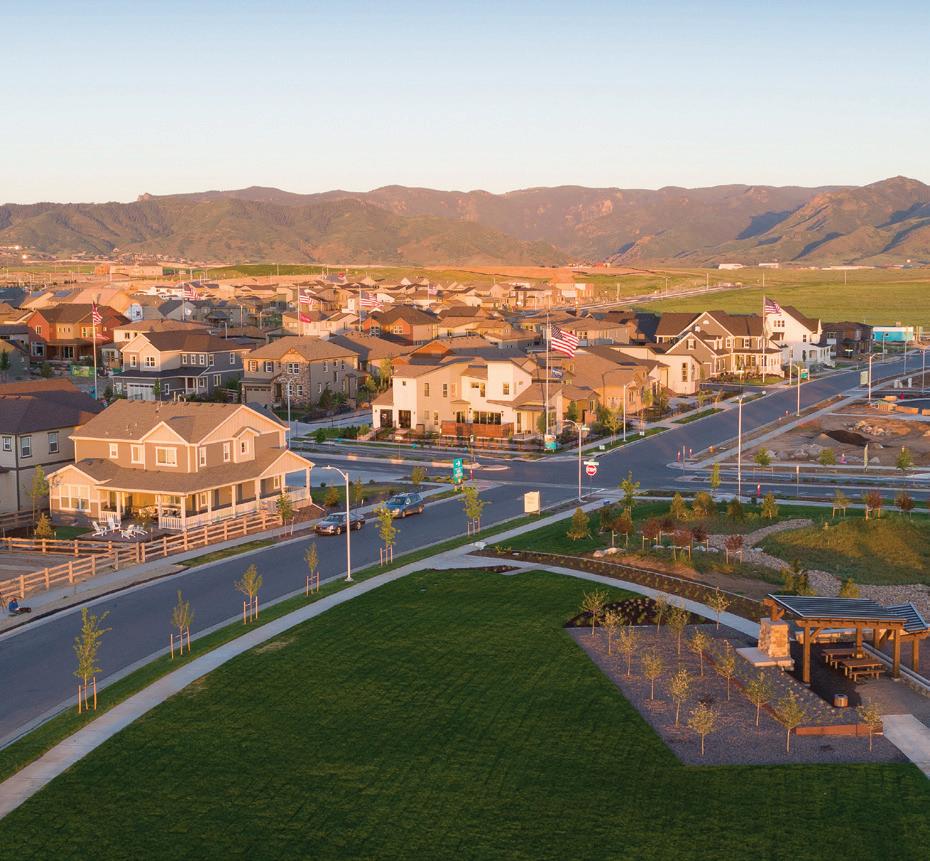
In 2009, the Colorado state legislature passed HB09-1129 to authorize up to 10 rainwater harvesting pilot projects, but only one emerged. Sterling Ranch, a master-planned housing community in northwest Douglas County, designed its homes amidst an innovative network of rainwater runoff ponds to feed irrigation systems for neighborhood parks. It’s the state’s first and only regional rainwater harvesting project, and it promises to chart a new and more conservation-minded course for Douglas County, where almost all development draws from nonrenewable groundwater.
But the entire state is watching Sterling Ranch to
see if it can pave the way for other developments that might integrate rainwater harvesting and, consequently, reduce homes’ demand for potable water. A key legislative barrier fell in 2024, when the Colorado legislature clarified the legality of capturing “rainwater” before it became “stormwater.” For years, the rain harvesting design had been arrested by semantics. Now, Sterling Ranch is poised to operationalize its design: phase one will capture about 60 acre-feet of water per year. At full buildout, that number could approach 400 acre-feet and create a community that sources 90% of its water from renewable systems.
Water Conservation Board funded a 25-home pilot project by Greyter Water Systems, Lennar Homes and Denver Water, which installed built-in graywater systems and advanced leak detection in new construction in Denver’s Central Park neighborhood. Seven of those initial installations have been disconnected because of annual costs associated with backflow prevention and water quality testing. When graywater systems aren’t built into construction from the start, it can be even more costly — instead, community-scale water reuse systems can be a more effective approach to recycling water.
WATER REUSE AND RECYCLING
Water reuse is increasing in Colorado. As of 2024, nearly 30 Colorado cities reuse water, according to WaterReuse Colorado. Reuse is a large-scale process in which communities purify their wastewater to a high degree in order to recycle it for use in anything from landscaping to drinking and other domestic uses.
In Colorado, state law specifies which water supplies can be legally reused. Legally reusable water supplies cannot decrease return flows that other in-basin water rights holders rely on. Examples of reusable supplies include most transmountain diversion water, non-tributary groundwater, and transferred consumptive use supplies. Because of this limitation, some communities cannot legally reuse their water.
Health regulations also govern how water providers can implement reuse. The Colorado Department of Public Health and Environment’s Regulation 84, which governs nonpotable water reuse, was first adopted in 2000. The regulation has been updated multiple times since to include more and more uses for recycled nonpotable water which now range from landscaping to toilet flushing to industrial uses and many others. In November 2022, the Colorado Water Quality Control Commission approved a new rule governing direct potable reuse (DPR), and incorporated it into Regulation 11: Colorado’s Primary Drinking Water Regulation. DPR occurs when reclaimed wastewater passes through multiple phases of advanced water purification processes to became a safe, reliable drinking water source.
By reusing water, some municipalities can stretch their limited water supplies, taking pressure off of rivers to meet demands in a reliable way.
INCENTIVES FOR EFFICIENT HOUSEHOLD WATER USE
Financial incentives such as rebate programs and conservationoriented water rate structures are often offered by water providers, or occasionally watershed groups, universities, state agencies and local public interest groups.
1. Conservation Water Rates
Conservation-oriented water rates are an important component of any water conservation program because they convey a message about the value of water. Historically, water rates were set at flat, break-even prices to ensure affordable and accessible water. Flat rates, which do not charge higher prices for higher volumes of water use, can still be set to cover the cost of service incurred by a water provider, but inadvertently encourage water waste due to the lack
of a price signal. Now, more than half of Colorado’s municipal water providers use some form of water conservation pricing to motivate customers to use water more efficiently.
2 . Rebates
Some water providers offer rebates to minimize the financial barriers that stand in the way for consumers to make efficiency upgrades. Although Colorado's SB14-103 prohibited the sale of lowefficiency plumbing fixtures in Colorado beginning in September 2016, many households and businesses continue to use older models that were installed before the mandate. To address that gap, many water providers offer incentives to switch to newer, higher efficiency models. Most focus on toilets. In 2021, Colorado Springs Utilities began offering a $100 rebate incentive for 0.8 gallon per flush toilets, and Greeley does the same. Denver Water offers a $100 rebate when users switch to a toilet that uses 1.1 gallons per flush or less. In Glenwood Springs, rebates include $35 for a sink faucet.
Colorado’s water providers also use rebates to focus on outdoor water conservation. Denver Water offers rebates on rotary or highefficiency sprinkler nozzles and up to a $75 rebate on WaterSenselabeled smart irrigation controllers — starting in 2026, WaterSense irrigation controllers must meet water efficiency and performance criteria of that standard, under HB23-1161. Greeley provides rebates of 50% off the purchase price of recommended smart controllers, weather sensors, and sprinkler nozzles. The Eagle River Water and Sanitation District offers homeowners 25% off of smart irrigation controllers up to $200, and 25% off of irrigation system upgrades up to $1,500.
Others encourage the installation of water-wise landscaping, turf replacement, and other landscape conversions. Castle Rock, Glenwood Springs and the Eagle River Water and Sanitation District offer buy-back programs that pay homeowners $2 per square foot for replacing irrigated, non-native turf with water-wise alternatives. Aurora Water conducts a Grass Replacement Incentive Program (GRIP) that issues up to $4,000 for pre-approved landscape conversions. Beginning in 2016, Colorado Springs offered a turf-tonative rebate program for any commercial customer who was willing to remove turf and install native grasses. Through this program and through direct retrofits prior to 2016, Colorado Springs city parks converted 80 acres of non-essential turf to native grasses. In 2022, the state allocated $2 million to the Colorado Water Conservation Board through HB22-1151 to create a statewide turf replacement program that matches community turf replacement funds and expands program reach.
To improve the success of their rebate programs, Aurora Water, Colorado Springs Utilities, Denver Water, Northern Water, Castle Rock and others offer classes and demonstration garden programming about the design and installation of water-wise landscapes.
BEST PRACTICES FOR MULTIFAMILY AND HOMEOWNERS ASSOCIATIONS
As water providers expand their outreach to homeowners and businesses to encourage conservation practices, they’re also developing programs to suit a building category that falls somewhere in between those categories: Multifamily developments. Best practices for working with multifamily developments include:
The Benefits and Drawbacks of Artificial Turf
Artificial turf has been explored in recent years as a potential water conserving landscape alternative to cool season turfgrass. Western Resource Advocates’ “Is Artificial Turf a Beneficial Water Conservation Tool in the West” report details benefits and drawbacks of artificial turf.
WATER IMPACTS
Artificial turf lawns and football fields can save up to 70% of the water used on cool season turfgrass landscapes. However, some water is needed for maintenance and sanitation, and on hot days, for cooling the turf surface. Artificial turfgrass absorbs heat from the sun, in some cases making the turf up to twice as hot as the ambient air temperature. This exacerbates the urban heat island effect and can require large amounts of water to cool the surface down for recreational use on hot days. Additionally, artificial turf can block groundwater recharge and increase stormwater runoff.
CHEMICAL AND
MICROPLASTIC
CONCERNS
Artificial turf reduces the need for fertilizers or pesticides typically used on Kentucky Bluegrass. However, studies have found 197 carcinogenic chemicals in artificial turf crumb rubber infill material, which is typically used on artificial sports fields. Microplastic pollution is an additional concern, as infill materials and the artificial grass blades can migrate into the surrounding environment. These plastic materials can contain PFAS chemicals, which have been shown to be dangerous to human and animal health.
LIFECYCLE IMPACTS
Artificial turf lasts 8-10 years on average, and has no effective large-scale recycling solution, although progress is being made in that direction. Most artificial turf is currently dumped in landfills, or illegally to avoid expensive landfill fees. This creates additional fire hazards in communities.
Artificial turf can have useful applications, but due to impacts on water, increased urban heat island effect, and chemical, and lifecycle impact concerns, water-wise landscaping with low water, climate appropriate plants is a better tool for water conservation and provides numerous other environmental and community benefits. Waterwise landscaping and native grasses require fewer inputs than cool season turf, and help to mitigate urban heat island effect, reduce water use, and increase pollinator habitat.

1. Infrastructure Inventory
Locate and map the infrastructure at the property. This basic inventory allows a property owner to better understand how its water is used and to know the points of shut-off in the case of a break. Infrastructure to inventory can include main building shut-off valves, meters, backflow prevention devices, irrigation controllers, irrigation zones, rain sensors, weather stations, pool mechanical systems, boilers, cooling towers, and more. Many properties do not have this information, or don’t have it all in one place.
2 . Leak Management Plan
The management team should devise a plan for when a leak happens. The plan will prevent long-term water waste, property damage, and high water bills. A successful leak management plan incorporates four items:
• Access — Guaranteed access to units in case of an emergency.
• Contact — Identify a contact person(s) for residents who will respond immediately. The contact should have access to the leak response process, infrastructure map, property management company, and preferred contractors.
• Structure — Outline of the leak response process which includes identification information and repair procedures.
• Data — Access to water usage information from the water provider, which may include bill and usage data, customer portal with analysis capabilities, or smart meter data with leak alert settings.
3. Regular Irrigation System Audits
Audits are extremely helpful for large properties. Although basic maintenance may be performed by landscapers, system-wide issues and non-urgent but inefficient problems may be ignored. Multifamily properties and HOA common areas should receive an irrigation audit every two to three years. Breaks and inefficiencies should be addressed immediately, as these issues can worsen over time. Many water utilities offer audits at reduced or no cost.
EDUCATION, TECHNICAL ASSISTANCE AND NEXT STEPS
1. Education and Outreach Programs
Virtually every municipal water provider in Colorado invests in some form of community outreach or public education. Traditional methods focus on K-12 education programs, mass media and social media, which are still effective ways to reach most customers. Most utilities also highlight information on efficient water use and conservation programming on their websites. Large water utilities hire staff with expertise in public relations and education and contract professional marketing firms to design and implement public awareness campaigns.
Typical water providers’ education programs include water use audits, displays at public events such as farmers markets, demonstration gardens showcasing water-wise landscaping, social media and traditional media outreach, and workshops or training programs on specialized topics such as irrigation scheduling. For children, many utilities fund water-related educational materials, classroom programs, and large water festivals for schools.
Landscape professionals and green industry members from around the state also can receive water conservation and efficiency best management practice educational programming hosted by the Associated Landscape Contractors of Colorado, and other organizations. The national Qualified Water Efficient Landscaper Certification also offers training opportunities to help landscape professionals implement best practices in water conservation.
Public education efforts to raise awareness and foster behavior change are critical in all conservation efforts. Central outreach components, according to the 2024 Colorado WaterWise Best Practices Guidebook, include effectively communicating the value of water, delivering consistent and persistent messages, and providing customers with timely information on their water consumption along with alerts when unusual usage is detected. The guidebook highlights the need for water providers to collect and maintain electronic contact information to communicate with their customers.
The combined results of such programs have been significant, but because residential users have responded well to education, changes in rates, incentives and other tools, it may be difficult to make steady progress with residential conservation in the future. Next-step measures for water conservation will require additional consumer initiative and behavior change. These may include upgrading irrigation systems, upgrading to weather-based smart irrigation systems, or using shower timers to limit water use, as well as utility-side measures like smart metering, leak detection, and more on-site water audits.
2 . Advanced Metering Infrastructure (AMI) and Smart Meters
Water providers are increasingly taking advantage of innovative meter technologies that are capable of tracking data that can inform conservation objectives. Ranging in functionality, AMI collects household water use data in real time or regular intervals and can convey that information to both the local water provider and the consumer in a fully functional implementation. Enrolled customers may receive personalized communication through an AMI data portal, which may improve understanding of pricing tiers, boost water monitoring to make better decisions about water use, and more. Water providers can use the data to better assess issues from off-site locations, more quickly detect leaks, efficiently manage pipes, predict problems, and bill customers based on actual usage and water consumption data rather than estimates. Submetering allows water providers to differentiate demands within one large, multipurpose building (such as a multifamily residence or office complex).
Today, all Colorado water providers serving more than 600 customers must provide meters and metered-based billing to their customers, and many, though not all, are using smart meters. Smart metering is used in Colorado Springs, Cortez, Fort Collins, Westminster and other communities. Smart metering is relatively new, and research to demonstrate its effect on water use has been limited. Without a customer portal or leak detection system with alerts, smart metering does not save water. However, when a feedback component is included, smart metering can be effective. While AMI portals can alert customers to leaks through highusage alerts, customers can also install their own leak detector. Many of these models — from brands including Phyn, Flume and Moen — monitor household water consumption by tracking anomalies in use, and some can automatically shut off the water supply line to prevent water damage from leaks.
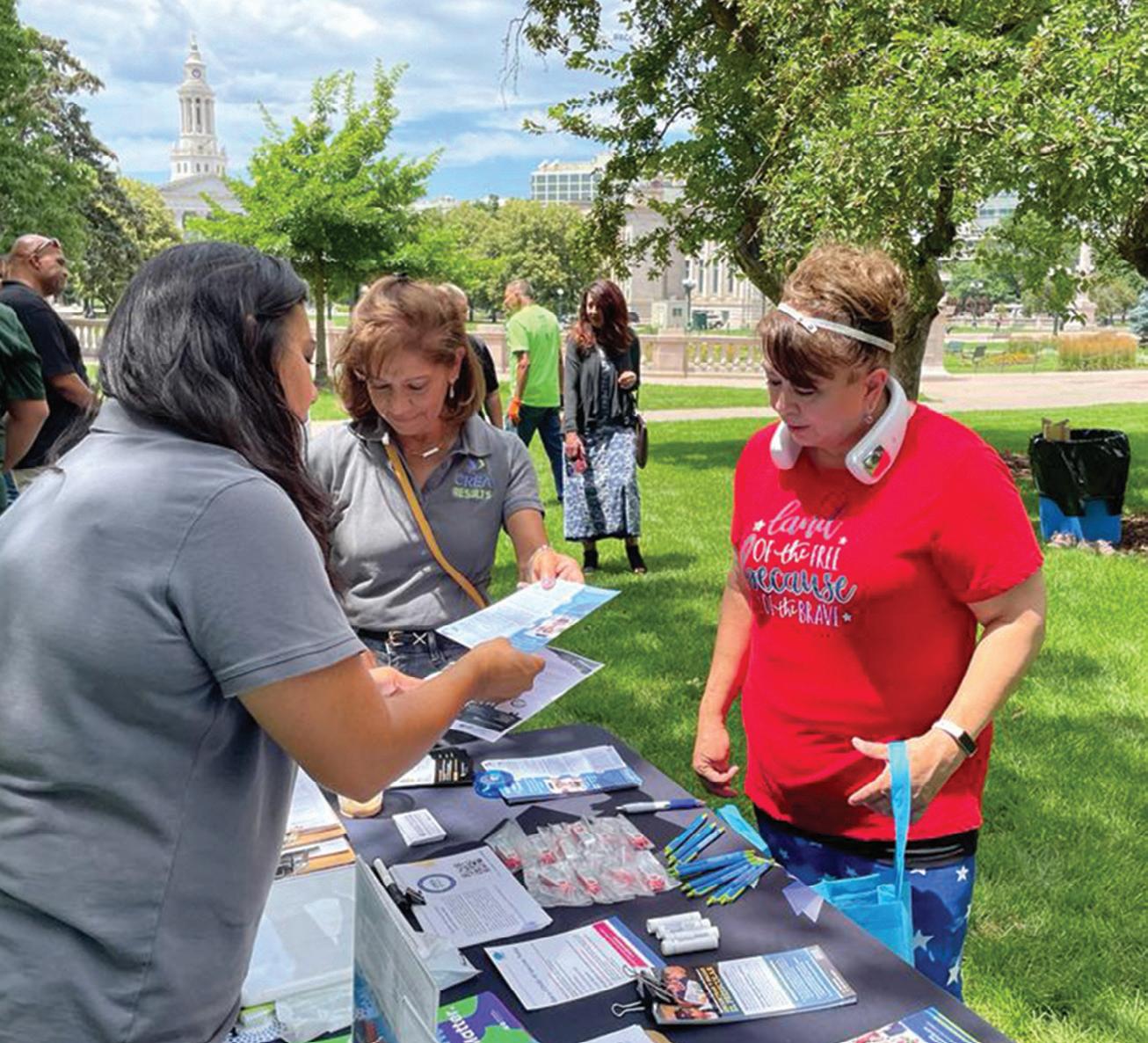
3. Customer Feedback
Accessing real-time metering data online isn’t the only way for customers to make decisions about their actual water use. Many water providers send mail-based usage data, with some providing social comparison feedback so customers can compare their water use to that of their neighbors, a process called social norming. In 2014, Fort Collins Utilities started sending some customers a home water report every other month with the aim of motivating customers to reduce their water use. As of 2016, they reached 75% of their customers with these reports and found them to be a cost-effective method to make customers more aware and reduce their water use. A 2011 paper that appeared in the American Economic Review found that water providers that incorporated social comparisons caused a lasting and persistent reduction in water consumption. The study reported about a 5% reduction in water use when social comparisons were used to encourage water conservation and found that those reductions were durable — with social comparison messaging likely leading to lasting conservation investments like fixing leaks and adopting water-saving technologies.
NEW DEVELOPMENT
Population growth is a driver of municipal water demand. Since the early 2000s, Colorado’s population has increased by more than a million people, reaching 5.9 million in July 2023. State Demography Office projections from that same year estimate a 2050 population of 7.4 million. New housing and construction will be needed offering an opportunity to rethink the way Colorado grows with coordinated water and land use planning. According to the 2023 Colorado
Water Plan, the manner in which the state grows will have a strong influence on Colorado’s future water supply gap and vice versa. The plan emphasizes the need to integrate water and land-use planning, preferably by using a holistic One Water ethic that coordinates water utility efforts, land use planning, and alternative water supplies (e.g. raw water and reuse). Since 2017, the Colorado Water and Land Use Planning Alliance has brought together various stakeholders to share ideas, practices and projects for combining visions for water and land use. The group also advances policy that supports the water plan’s goals to implement land-use codes, zoning regulations, and development guidelines that promote water conservation.
Certain land use patterns, like planning new development on smaller lots or designing homes and landscapes to adhere to a water budget, can dramatically lower water demand. Increases in housing density, for example, result in smaller landscaped areas and can lead to corresponding reductions in outdoor water use. The Colorado Water Conservation Board reports that a 20% increase in density yields a 10% per-capita water savings. The 2024 Colorado WaterWise Best Practices Guidebook states that factors such as the number of dwelling units, other land uses, and total landscaped area drive total water demand.
Building water efficiency into new growth can lock in future water savings by accounting for the effect of lot size and landscape choices at the outset. This also reduces, to some extent, dependence on the customer’s initiative and investment in achieving water conservation targets. Recognizing these connections, Growing Water Smart, a program of the Sonoran Institute and the Babbitt Center for Land and Water Policy, trains municipal representatives across the West on best practices in integrating land and water planning and management. Sixty-eight percent of Colorado's population now lives in a city or county that has participated in a Growing Water Smart workshop, with 58 communities so far that have learned and begun to implement land and water planning integration strategies.
WATER CONSERVING TOOLS FOR NEW CONSTRUCTION
1. Conservation-Based Connection Charges
Also known as tap fees, impact fees, system development charges, or plant investment fees, these charges can be structured to encourage developers to build efficiency into new developments, supporting sustainable growth. Colorado's HB25-1211 requires water districts to consider conservation-related factors when determining tap fee amounts. Even before 2025, several communities set conservation-based tap fees. Aurora, for example, uses a sliding scale to set its tap fees, based on the expected water usage of the construction’s outdoor landscaping. As of 2025, irrigation connection charges for residential landscapes that use high-water, cool season turf are charged at $5.80 per square foot, while water-wise landscapes are charged at $3.10 per square foot. Similarly, in Fountain, connection charges for new residential homes are determined, in part, by the type of landscaping on a property. Water-conserving landscapes pay much less than turf-only landscapes — property with turf covering 50% of the landscapeable area is charged half of the connection charge, and property with turf on 30% or less of the total landscaped area pays 30% of the full fee. Since mid-2014, 100% of proposed new residential homes feature waterconserving landscapes, and now, city staff hope to implement landscape standards that improve aesthetics while maintaining water efficiency.
2 . Policies and Planning Tools
In Colorado, any town or county with more than 25,000 residents must develop a master plan to guide its land use. Zoning ordinances and development regulations also tie land use and water use together. A best practice, according to the 2024 Colorado WaterWise Best Practices Guidebook, is for community planners to work closely with water providers when updating development regulations in order to minimize the water demands of development. As part of SB24-174, municipal, county and regional comprehensive plans must include a strategic growth element and a water supply element by the end of 2026 and must be updated on no less than a 5-year basis. Additionally, a water conservation policy and an estimate of water supplies needed to accommodate the potential growth in the plan are required. Before this bill passed, a water element was not required in comprehensive plans. Other innovative applications of land use rules have been implemented recently. Buena Vista, for example, passed an ordinance in 2023 that ties water use for new development to community priorities that include workforce housing. Buena Vista was on track to run out of dry-year water for new developments by 2030, and consequently seeks to foster the types of development that the community needs most.
By The Numbers
Percent of per-capita water savings expected from a 20% increase in density
Zoning, building and land use codes direct development. Today Denver, Boulder and other cities set “minimum” densities which limit the size of lots and lawns, enabling more efficient water delivery systems and requiring less costly infrastructure. Most cities aren’t pushing for smaller lot sizes to limit water consumption — it’s dictated by the market — but minimum density requirements, mixed-use zoning, and open-space designations allow for more efficient water use.
Landscape ordinances can also integrate water efficiency into land use plans. In 2022, Aurora adopted an ordinance that prohibits the use of cool-season, high-water turf on residential front lawns — and in back yards, turf area is limited to 45% or 500 square feet, whichever is less. No spray irrigation is permitted from curb to sidewalk, except for initial, temporary use to establish native vegetation. Commercial and multi-family properties can apply for permission to use cool-season turf in functional spaces, such as an employee lunch site, but even that requires passive irrigation. With the landscape ordinance in place, Aurora’s city staff hope to reduce outdoor water use among residential properties by 25% to 30%, while commercial and multi-family developments are expected to achieve more than 30% savings in outdoor water use.
In the Roaring Fork Valley, Ruedi Water and Power Authority worked with area water providers and stakeholders to create the Regional Water Efficiency Plan. The first of its kind to coordinate efforts throughout the Roaring Fork watershed, the plan references
individual efficiency plans drafted by collaborating municipalities while also developing overarching goals that regional hotels, landscapers, and land managers can reference to steer their practices toward water conservation. The plan created a model landscape ordinance to address water use across the valley — encouraging the use of native vegetation, limiting turf coverage, and establishing landscape water budgets.
Statewide laws have since expanded such conservation measures. The 2024 passage of Colorado’s SB24-005 prohibits the installation of non-functional turf in new development and redevelopment on commercial, institutional and industrial properties. The legislation takes effect in January 2026. Using a grant from the Colorado Water Conservation Board, Western Resource Advocates and Brendle Group created resources to help communities comply with the legislation. The resources include a key considerations guide with links to model land use code examples, examples of compliant Colorado codes, and a list of allowable plants. In 2024, the Colorado Department of Local Affairs drafted example language for communities to use in their landscape codes that complies with SB24-005.
3. Green Building Codes and Methodologies
Green building codes create a higher standard in energy and water efficiency than standard building codes and provide a tool for guiding construction and development in a more sustainable manner. Green building methodologies can also go beyond what is required by code to encourage higher efficiency. Boulder, Denver, Durango, Telluride, Eagle County, and other cities and counties across the state have programs that encourage green building and water use reductions and often mandate them for city buildings. LEED programs address indoor and outdoor water efficiency, land use and water quality to some degree but focus more heavily on energy efficiency. Beginning in 2006, the U.S. EPA’s WaterSense provided the first national certification for water-efficient new homes, delivering a 20% more water-efficient building. Colorado has been an early adopter of the WaterSense criteria for new homes. Arras Park, a 292-residence development comprising single-family homes and townhomes in Thornton, ranks among Colorado’s largest certified WaterSense communities, and one of the largest nationwide. HB10-1358 also required builders of single-family detached residences to offer buyers the opportunity to select from a variety of water-smart options at the time of construction.
WATER LOSS CONTROL AND MANAGEMENT
Municipal water suppliers can conserve by delivering water efficiently. According to the 2023 Colorado Water Plan, approximately 120,000 acre-feet or 12% of municipal water demand in the state is lost en route to its destination. Water utilities rely on water loss audits to prioritize interventions such as leak detection, meter testing, and real loss component analysis to maintain the integrity of their distribution system, increase efficiency, and recover lost revenue. Improving loss measurement and tracking systems was highlighted as a priority in the 2023 Colorado Water Plan. As of 2024, the Colorado Water Conservation Board requires water providers
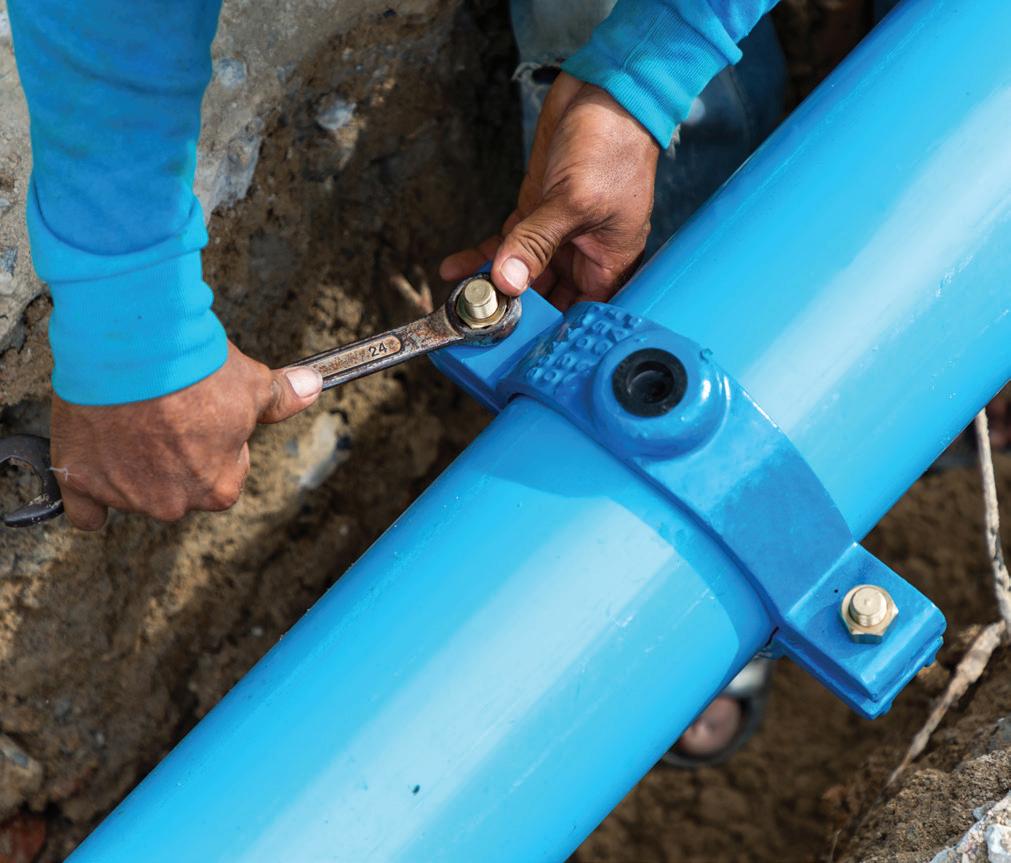
Colorado Water Loss Initiative
In 2018, the Colorado Water Conservation Board rolled out a sweeping program that provides training and technical assistance for water systems to enable them to develop water loss programs. Called the Colorado Water Loss Initiative (CWLI), the program has so far carried out 29 in-depth workshops along with consultations with individual utilities to support their completion and validation of water loss audits.
Improving water audit methodologies and data collection is a goal of the 2023 Colorado Water Plan. With better data, urban communities are better equipped to identify sources of water loss and evaluate solutions. Thus the CWLI team offers water utilities technical assistance in source meter testing, billing data analysis and prorating, customer meter test design and result analysis, real loss component analysis, leak detection, and audit compilation and validation. From 2018-2020, water
utilities showed a marked improvement in their data validity scores resulting in more accurate water loss audits that help utilities target relevant interventions.
CWLI’s Phase 2, from 2021-2025, targets supply meter testing because inaccurate meters can misrepresent water losses by significant margins.
In a real-world example involving two utilities that wanted to develop a real loss intervention strategy, one utility conducted testing to confirm that their flow meter, which gauges water coming into the system, was measuring an actual water loss. That utility decided to proceed with loss intervention.
The other utility, however, learned through testing that its supply meter was over-registering by 5.6% and overstating their actual losses by double. This utility addressed the inaccurate metering and sidelined loss intervention strategies that they didn’t ultimately need.
to submit completed water loss audits as part of their state data reporting requirements.
Water loss control programs identify real, or physical losses of water from the distribution system as well as apparent losses, or water that is consumed, but not billed for due to inaccurate metering, unauthorized consumption, or data handling errors. Any water that is not reflected in customer billing, whether due to physical or apparent losses, is considered “non-revenue water.”
Once issues are identified through a validated water loss audit, a water provider can prioritize a number of interventions, such as supply meter testing, customer meter test design and results analysis, billing data analysis and prorating, real loss component analysis, implementation of district metered areas, and leak detection.
For physical losses, using sophisticated sonic devices that detect the sound of moving water, utilities can pinpoint the exact location of leaks in buried transmission lines. Municipal water providers may also use statistical models to predict the remaining useful life of buried mains by analyzing data on pipe material, leak history, pipe installation date, and soil composition.
For apparent losses, testing source meters that leave treatment plants or properly designing and installing meters at homes and businesses, enables water utilities to accurately measure the amount of water leaving the plant versus the amount being delivered to customers. According to a Western Resource Advocates and McKinstry 2015 report “Tapping the Power of the Market,” meter replacements enabled by performance contracting in Colorado, if adopted at a 40% rate, could result in 39,000 acre-feet of reduced apparent water loss.
Supported by the Colorado Water Conservation Board, the Colorado Water Loss Initiative (CWLI) is training approximately 90 water providers in water loss methodology on an ongoing basis, using the preferred M36 AWWA water loss control and management methodology. These free trainings provide comprehensive instruction and technical assistance for water systems across Colorado. Additionally, the Colorado Water Conservation Board convenes the Colorado Water Loss Control and Management Committee composed of water providers across the state to help institutionalize the best practice of water loss control and management and be a driver for water loss advancement across Colorado.
By reducing water loss, water utilities can maximize their supplies and maintain their revenue for water already being treated and delivered through their systems, which also saves energy and treatment cost.
DEMAND FORECASTING
Long-term water demand forecasting is a critical tool used by water managers. Water providers face an uncertain future. They don’t know how population, climate or the economy will change in their service areas, and yet they must be prepared to meet customers’ demands. Water demand forecasting and water supply planning have become increasingly sophisticated, but many utilities still develop demand forecasts the old-fashioned way — using population projections and estimated per-capita demand. This traditional forecasting method excludes principal factors that produce variability in water use. Therefore, due to resource constraints, concerns about climate change, and other uncertainties, more water managers are making it
THE FACTS ON LEAKS
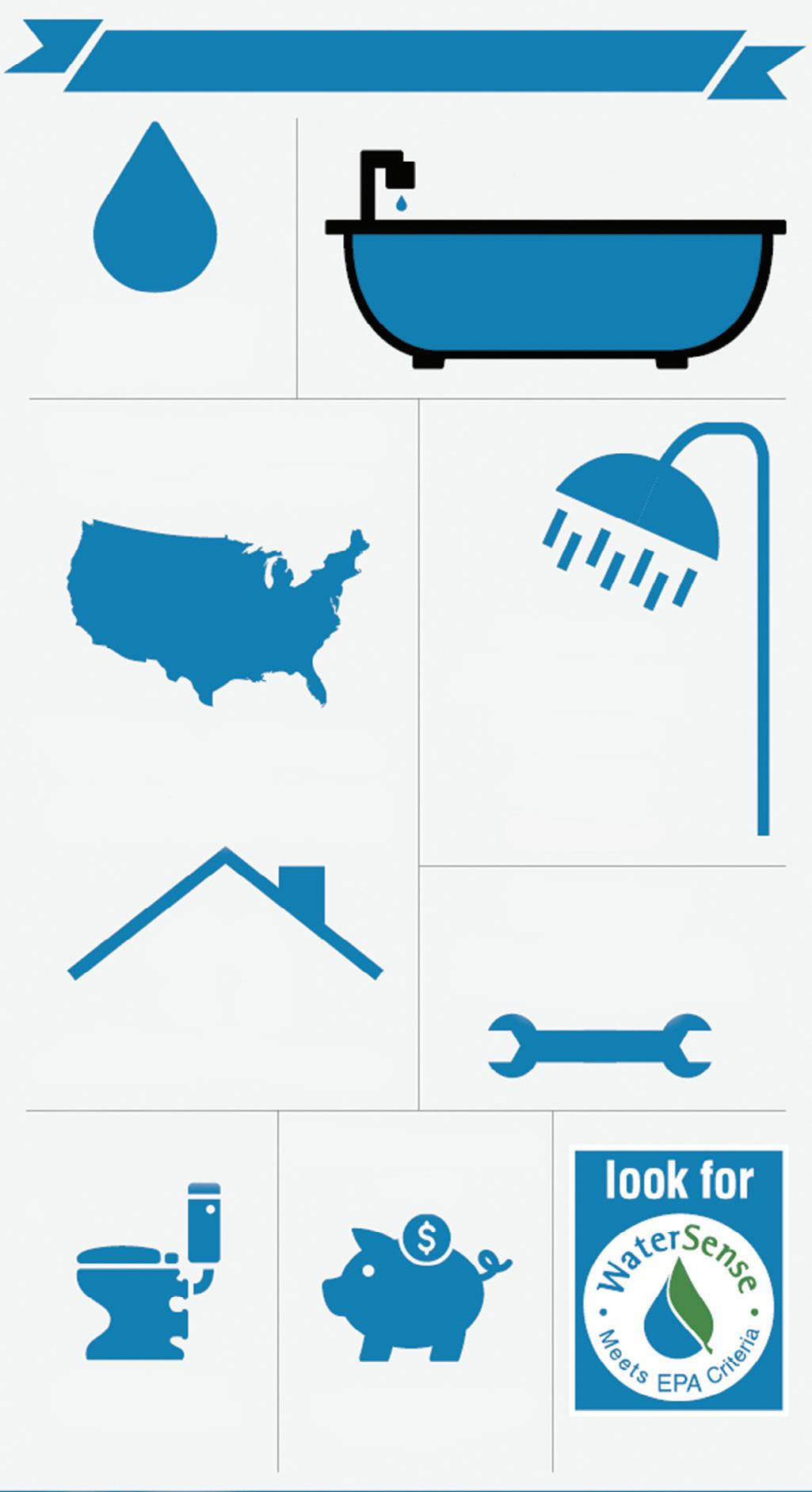
10
1
11
3,000 gallons
a priority to understand and model those factors that influence use in order to prepare for the future.
Integrated resource planning is a more comprehensive planning effort than traditional forecasting. Through integrated resource planning, supply-side and demand-side management options intersect, using least-cost planning and often incorporating water conservation programs as an option for meeting future water needs. This mode of planning often includes goal setting and demand monitoring to determine if a conservation goal has been met or is on target to be met, and can provide data for future planning. The planning process described under the statute that requires conservation plans to be filed with the Colorado Water Conservation Board follows the methods of integrated resource planning and can be used as a reference for utilities. The Alliance for Water Efficiency also has a water conservation tracking tool for integrated resource planning. This tool tracks water savings and
compares multiple conservation scenarios to determine the best combination of activities.
By having good predictions of what the future may hold, and goals for that future, water providers can make better investment choices and adjust their work to achieve their goals. Planning is essential in implementing conservation measures and permanently reducing demand. Conservation and customer behavior are among the many factors that make their way into demand forecasts and water supply planning. Planners must also build in some cushion for drought.
As a municipal system grows more efficient, implements permanent watering rules, or changes its landscape, it can become increasingly challenging to significantly reduce customer demand during a drought or shortage. The system therefore loses some of its cushion, experiencing what’s known as “demand hardening.” However, research from the Alliance for Water Efficiency’s 2015 “An Assessment of Increasing Water-Use Efficiency on Demand Hardening” report demonstrates that long-term water efficiency and conservation measures don’t diminish customers’ ability to respond to water shortages. The report offers recommendations for drought planning to prevent demand hardening from becoming a reality. These recommendations include cutting outdoor use first during times of drought and as outdoor use is reduced, early targeting of indoor water use and mandatory water use restrictions, along with many others. The report suggests that concern about demand hardening can be managed through a well-designed water shortage contingency plan. Additionally, deficit watering during drought can result in significant landscape damage if proactive measures aren’t taken to ensure landscape resilience. The 2024 Colorado WaterWise Best Practices Guidebook recommends landscape choices that are drought tolerant in order to boost drought resiliency and decrease landscape mortality when water restrictions are in place.
CHALLENGES TO EFFICIENT WATER USE IN HOMES AND CITIES
A number of challenges stand in the way of improving efficient water use among Colorado’s municipalities.
Providing sufficient revenue and ensuring fairness and equity while protecting low income customers are typical objectives for a utility water rate structure. For water providers to successfully send a price signal to conserve, while also implementing maintenance upgrades required by aging infrastructure, they may have to identify more dramatic increases between rate blocks. Greeley, for example, has instituted a pricing scale that increases with use, so that residences and businesses that exceed expected water use pay more for that water. At the highest price tier, users pay $11.81 per 1,000 gallons of water, compared to $5.61 per 1,000 gallons in the lowestcost bracket.
Such progressive price structures may ease concerns about residents’ ability to pay higher rates. As municipalities discuss raising water rates to encourage conservation, they must also consider water equity and how rising rates might disadvantage low-income residents. Consequently, some Colorado cities, including Longmont and Fort Collins, offer discounts to households that live at or below the state’s poverty line.
Aging infrastructure presents another challenge to conservation, forcing water providers to spend more of their
budgets on infrastructure repair, replacement and leak detection. These mounting costs on top of the need to allocate more resources to water conservation budgets can present a challenge to water providers as they seek customer buy-in for rate increases. While budgeting can be a challenge, conservation can save money. A 2013 paper “Conservation Limits Rate Increases for a Colorado Utility” focused on the City of Westminster and found that reduced water use had resulted in significant savings in both water resources and infrastructure costs, saving residents 80% in tap fees and 91% in rates compared to what they would have been without conservation.
Finally, a lack of awareness or understanding is an ongoing challenge. While consumer behavior is changing, education to increase public understanding continues to be vital. Informing customers about how they can conserve and why they should remains an ongoing necessity in order to achieve widespread implementation and perpetuation of conservation practices.
Live Like You Love It
Colorado WaterWise launched Live Like You Love It in 2014 to deliver a unified message about the value of water and the need to conserve it around the state. Since then, an array of targeted campaigns have called to “stop the algae monster” by reducing the use of algae-promoting fertilizers,
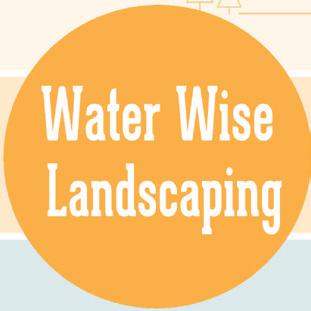
and identified “Fourteeners,” a list of 14 water conservation strategies that honors the state’s 14,000-foot-plus peaks. Check out these and additional resources, including best practices for water-wise landscaping, seen below, and more, at www.lovecoloradowater.org.
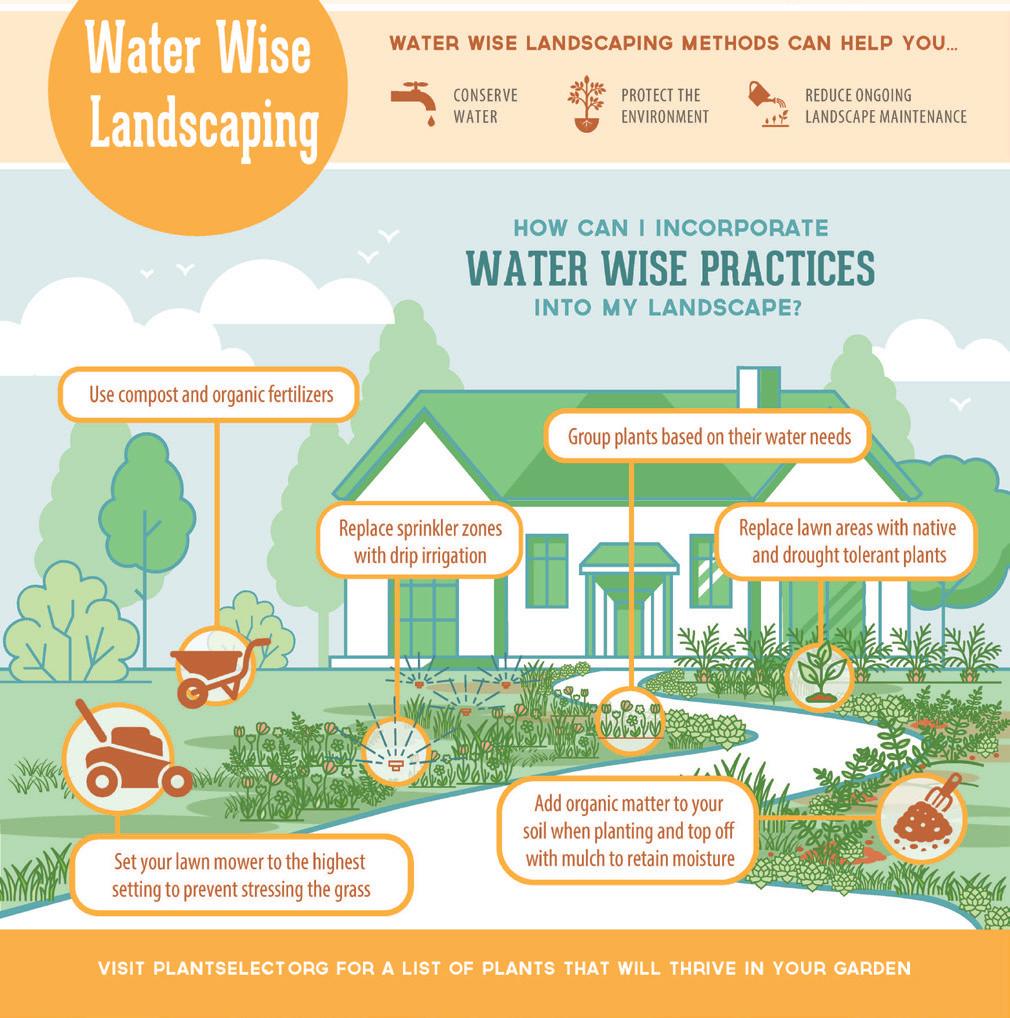
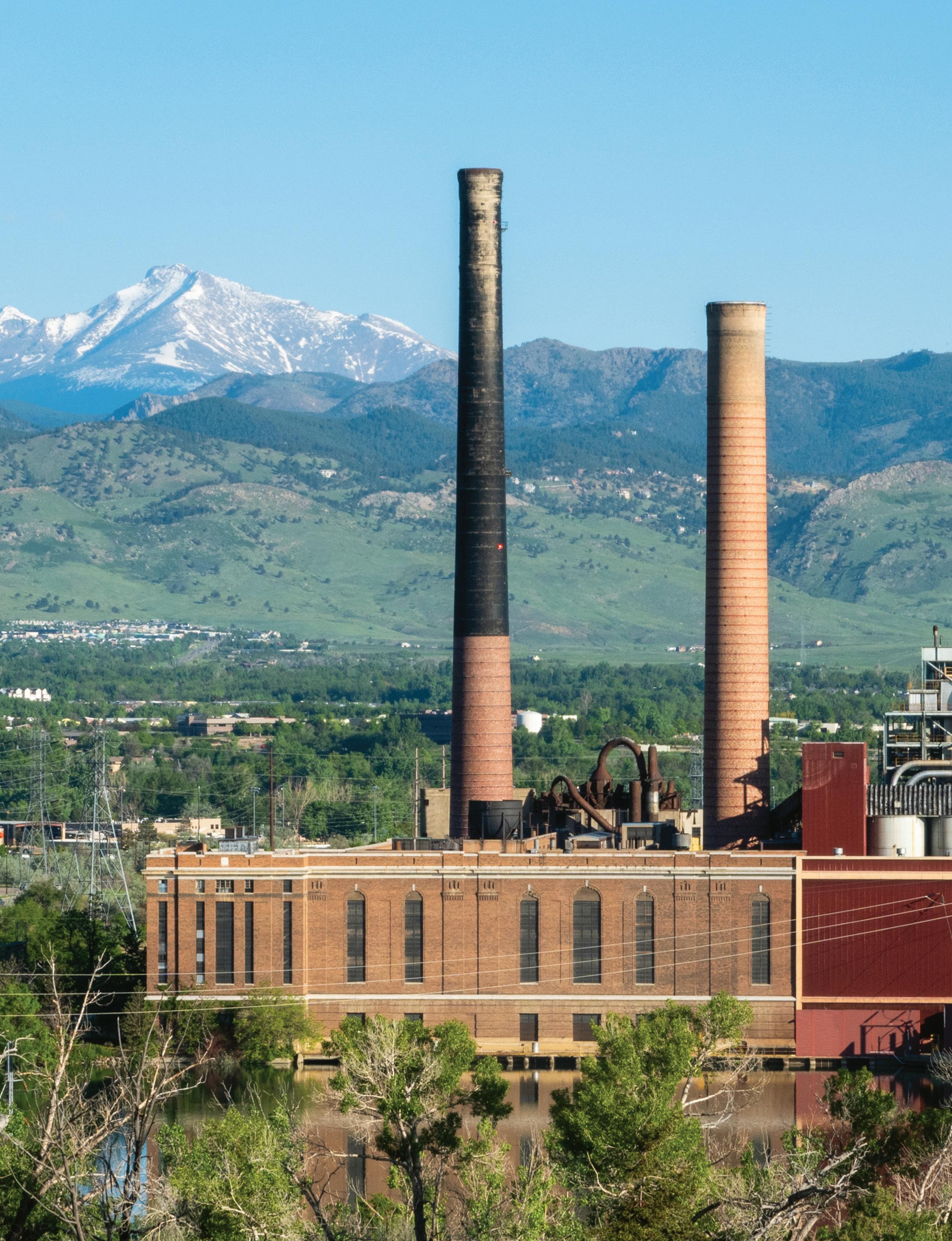
There are various ways in which water is used for commerce and industry. Some industrial water users are self supplied, while others get their water through municipal systems.
Although many water providers offer conservation programs to their commercial, industrial and institutional customers, commonly referred to as CII, programs are often designed on a case-by-case basis. According to the application for a Colorado Water Plan Grant that the Rocky Mountain Section of the American Water Works Association received in 2024, there is little documentation on how to develop and implement a CII conservation and efficiency program.
Denver Water says it aims to reach its customers through tailored programs — from a florist to a restaurant to an industrial manufacturer — and though the conservation measures vary, customers in all classes have been willing to conserve.
Grand Junction, Ute Water Conservancy District, and Clifton Water District worked with the Brendle Group to conduct audits on six commercial and industrial businesses in the area. Water-saving opportunities varied from customer to customer. A high school was able to save the most water by upgrading its sprinkler system and making outdoor irrigation changes; a restaurant saw the most watersavings from upgrading its ice machine; and a printer was able to save the most water by upgrading to high-efficiency toilets and urinals.
Other commercial and industrial water users are self-supplied, including the major beer producer Molson Coors, mining and energy companies, thermoelectric power generators, the ski industry, food processors, and many others. Collectively these industries consume about 116,000 acre-feet of water annually, or 3% of Colorado water consumption, according to the 2023 Colorado Water Plan. Industrial diversion demand is about 13% of the total municipal and industrial water demand in the state. Self-supplied industrial water users do not currently experience water shortage gaps between the amount of water they need and the amount of water available to meet their needs. However, statewide municipal and industrial gaps are projected to increase in the future to be between 230,000 acrefeet per year and 740,000 acre-feet per year. Using water wisely in commerce and industry can significantly stretch water supplies.
HEATING AND COOLING
Cooling and heating systems are the largest water users in typical commercial, industrial and institutional facilities, including thermoelectric power plants. The cooling process accounts for 95% of the consumptive use in thermoelectric power generation, with Colorado’s thermoelectric power plants using 53,190 acrefeet of water annually, according to the 2019 Technical Update to the Colorado Water Plan — that’s 30% of industrial water use in Colorado, which equates to less than 1% of water consumption in the state. However, different types of power generation require different quantities of water. In Colorado, closed-loop cooling systems are used at natural gas plants, consuming around 200 gallons of water per megawatt-hour. While some coal-fired power plants consume closer to 600 gallons per megawatt-hour, Colorado’s electrical portfolio is shifting. By 2030, all of Colorado’s coal plants are scheduled to close or be converted to natural gas. As more renewable and alternative power supplies come online and
power providers determine how they’ll generate electricity in the future, the amount of water needed for power generation is less predictable. Electric utilities are planning to hold onto their water rights until the future becomes clearer.
Cooling towers or closed-loop cooling systems divert relatively small volumes of water. They remove heat by evaporation, resulting in relatively high consumption of the diverted water, approaching 75% to 80% consumption. According to Xcel Energy, cooling makes up more than 95% of a thermal power plant’s water needs, though that number varies among plants. Single-pass, once-through or open-loop cooling systems divert relatively high volumes of water, but have lower consumptive use because the water absorbs heat as it passes through the cooling process and is then discharged back to the river, where it increases evaporation from the river. According to the Colorado Water Plan, thermoelectric generating facilities in Colorado do not use once-through cooling systems due to the high water volumes required to provide reliable cooling supplies for electrical generation.
Water can be lost from cooling towers in two ways: evaporation and bleed-off. The largest volume of water is lost through evaporation. Bleed-off involves discharging a portion of the circulating water to remove suspended and dissolved solids — this process occurs in all cooling water systems but in power plants it is referred to as “blowdown.”
By
The Numbers
Percent of a thermal power plant's water needs used for cooling, according to Xcel Energy
Blowdown is used to maintain the water chemistry in the cooling system to ensure that the cooling tower infrastructure is not damaged by corrosion or deposition. Denver Water and power plant operators alike say that they have seen some of their highest industrial savings by working to increase the number of times water runs through a cooling tower before being drained to the wastewater system. As of 2024, so many systems in Denver Water’s service area participated in cooling tower rebates that the water provider no longer offers them.
Because evaporation rates are primarily controlled by the needed amount of cooling, evaporative losses offer limited opportunities for conserving water. Instead, facilities that want to improve the efficiency of cooling towers can use some of the following strategies.
1. Minimize Bleed-Off or Blowdown
Postpone the frequency of bleed-off or blowdown by improving the quality of cooling tower water — through chemical adjustments or filtration. The Alliance for Water Efficiency recommends installing submeters to monitor bleed on each cooling tower and installing
conductivity controllers, which measure conductivity and can add chemicals to control the pH of cooling tower water.
2 . Recycle and Reuse
It is possible to recycle bleed-off water for toilet flushing, for example, or to reuse water in a cooling system. These strategies are not commonly used in most cooling systems. At a power plant, blowdown water cannot be recycled because the water quality would damage and corrode pipes and fixtures if used further.
3. Install Closed-Loop Cooling Systems
Closed-loop systems recirculate cooling water instead of disposing it. These recirculating systems use water to cool steam, returning the vapor back to a liquid state before reentering it in the steam cycle. Many cooling systems, including those in power plants, aim to recycle water as many times as possible before blowing down and treating the wastewater. After recirculation, the water in some systems is treated and discharged back to the stream system in accordance with a discharge permit. Other systems retain wastewater on site and evaporate it. Closed-loop systems require lower water withdrawals than once-through systems, but have a higher consumptive-use rate of 70% to 80% according to Xcel Energy. Closed-loop systems are the most common systems employed in Colorado’s thermoelectric generating stations, used in all of Xcel’s thermal plants and in Tri-State Generation and Transmission’s Craig Station.
4. Replace Water-Cooled With Air-Cooled Equipment
Many facilities are researching the use of dry cooling which uses only ambient air to condense steam. This method has lower plant efficiency, a greater land footprint, and requires a higher electric load, all of which increase cost. These systems also depend on ambient air temperature for efficacy, working best on cold days and less so in the summer heat. However, some facilities, including an Xcel plant in Pueblo, have installed hybrid systems that use both air and water for cooling. The cooling load is met by the air cooling system when temperatures are low. These systems are increasingly supported by water cooling as the air cooling system efficacy is reduced by rising temperatures. Xcel Energy says its hybrid system cuts water consumption by approximately 50%.
Boilers and steam generators are often used to heat large buildings or complexes. Similar to cooling towers, the water in the boiler system is converted to steam. Therefore, like cooling towers, contaminants in a boiler’s water create opportunities for loss of heat transfer efficiency and equipment corrosion. For this reason, boilers often rely on a pre-treatment system to remove contaminants from water. Those systems require some blowdown to remove materials which are filtered out of the system.
Older boilers can experience water loss resulting from corroded steam traps and other deteriorated components that cause water to leak. Technologies that improve water use efficiency in heating systems include steam trap replacement kits, which prevent water losses from escaping steam; condensate return systems, which reduce the amount of make-up water needed by returning steam condensate to the boiler system for reuse; and auto match blowdown controls, which time bleed-off discharges to release only the amount of water necessary to maintain desired water quality.
Industrial Water Uses in Colorado
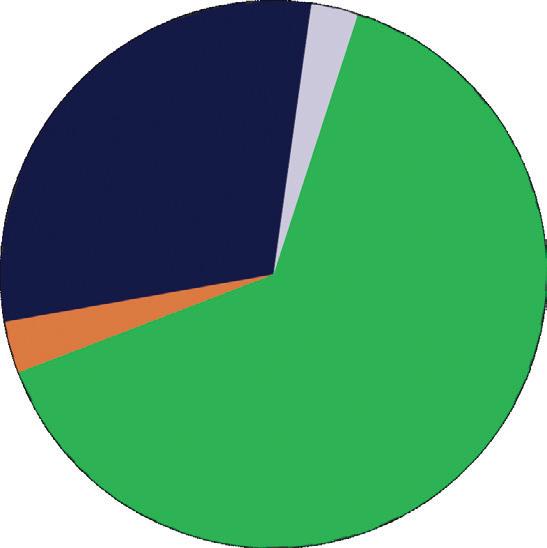
Water for industry accounts for 13% of Colorado's total municipal and industrial water use. The majority of that industrial water, 64%, is diverted by "large industry" — manufacturing falls into that category.
2019
INDOOR PLUMBING
%
High-efficiency plumbing offers a solution to water use in commercial and industrial restrooms. WaterSense toilets and urinals can save a significant amount of water in commercial facilities, while sink faucets and toilets may also be retrofitted to reduce water demand. High-traffic facilities such as passenger terminals, entertainment venues and office buildings can install WaterSense fixtures and sensor-activated control devices that release water from lavatory spigots, improving efficiency by preventing water from running in fixtures that are not in use. Savings can be significant. Recent water efficiency upgrades, initiated in 2022 at the Denver International Airport that include toilet and urinal flush valve retrofits, faucet flow restrictors and low-flow showerheads are guaranteed to reduce the airport’s water use by more than 28%.
LANDSCAPE IRRIGATION
Golf courses, sports fields, and other large, landscaped areas surrounding suburban office parks, industrial and institutional campuses, or communities can be responsible for considerable water demand. Large landscapes are prime candidates for conversion to water-wise designs, water-efficient irrigation systems, and aggressive management. Under the care of a qualified professional, these landscapes present significant opportunities for savings.
Colorado’s Senate Bill 24-005 prohibited local governments from allowing the installation, planting or placement of “nonfunctional turf,” artificial turf, or invasive plant species on certain properties including newly developed commercial, institutional and industrial properties.
Increasingly, there is funding available to support landscape conversions on commercial properties. According to a 2024 report from Western Resource Advocates and WaterNow Alliance, "Water Wise Landscapes," options to fund landscape conversions can include water provider incentives, special assessments, debt financing, and accumulated financial reserves.
In addition, landscape contractors and homebuilders can play a significant role in improving water use efficiency. An understanding of water-wise landscaping alternatives and the latest advances in water-efficient irrigation systems, as well as regular implementation of accepted best management practices, can decrease water demand at new developments and existing residential and commercial properties.
PROCESS WATER
Businesses and industries use process water to clean products; to transport or remove ingredients, products or contaminants; and to control pollution or dispose of waste. Process washing and rinsing are integral components of many manufacturing operations, including metal plating and finishing, paper production, and semiconductor chip fabrication. Process water is also used to develop
X-ray and photographic film. Because the amount of water required for processing varies according to its use, both demand and potential reductions in demand are site-specific.
Among the technologies that can improve the efficiency of process water use are smaller tanks in sinks for washing and rinsing, intermittent-flow rather than continuous-flow systems, and batch processing equipment. In-flow meters, control valves, or sensors allow flow rates to be adjusted to the minimum amount required and to be stopped as soon as rinsing or washing is completed.
OIL AND GAS EXTRACTION
Oil and gas development accounts for roughly 1% of Colorado’s total annual water diversions, according to the Colorado Division of Water Resources. September 2024 data from the database DrillingEdge shows 33,452 producing oil and gas wells in Colorado and more than 123,000 wells on file in the state. Water in oil and gas production is used primarily for drilling and completion — the process of bringing an oil or gas well into production. This includes cooling the drill bit, bringing drill-cuttings to the surface, and hydraulic fracturing.
During hydraulic fracturing, water mixed with sand and chemicals is pumped at high pressure down the well bore, creating tiny rock fractures that release oil and gas — most fracturing fluids are about 85% water, according to Frac Focus, the chemical disclosure registry. Water use in oil and gas operations varies based on the well type and location. Vertical wells use less water

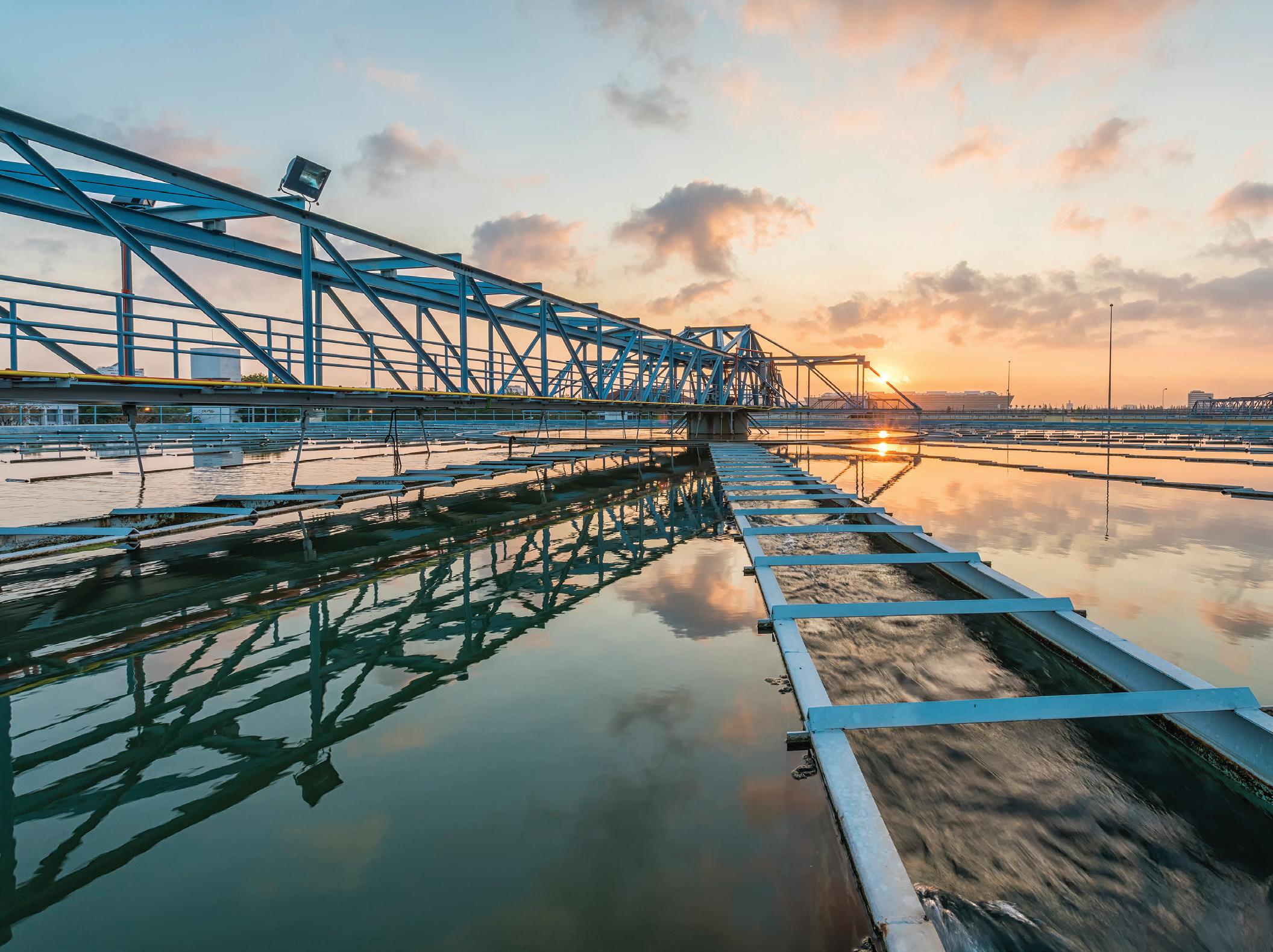
than horizontal wells, because they aren't as long. According to the U.S. Geological Survey, water use per well can be anywhere from 5 acre-feet to almost 50 acre-feet. The Colorado Energy and Carbon Management Commission’s (ECMC) 2023 Report on the Evaluation of Cumulative Impacts shows a statewide average of 37.44 acre-feet of water used per well.
Statewide estimated water use per oil and gas well decreased between 2022 and 2023, but has increased over the long term. Colorado operators doubled their use of water to prepare wells for hydraulic fracturing between 2013 and 2023, according to a 2023 report from the nonprofit Fracktracker Alliance.
Although water use for energy extraction may increase in the future, recycling that water could lessen demand. Most of the water used to develop a well, combined with any additional water emerging from the geologic formation with oil and gas, is so contaminated that the industry historically disposed of it by injecting it deep underground, completely removing it from the water cycle. With that in mind, state legislators passed HB 231242 which set up a Colorado Produced Water Consortium. Under the bill, the ECMC was required to adopt rules by early 2025 for reducing freshwater use and increasing the use of recycled water. As of 2023, the ECMC reported that 89% of the water used at oil and gas wells in Colorado was surface or groundwater, and just 11% was recycled produced water.
RECYCLING AND REUSE
Water reuse presents an opportunity to further stretch and efficiently use available water supplies. Water cannot legally
be reused everywhere in the state — only certain water rights can be reused. Water supplied through a transmountain diversion can be reused to extinction. Likewise, the consumptive use portion of water rights transferred out of agriculture as well as non-tributary groundwater are also reusable. There are a few categories of reuse:
1. Nonpotable Reuse
To date, most reuse systems in the state have been nonpotable, recycling water for use by commercial, industrial and institutional consumers. In a nonpotable reuse system, municipal water providers treat return flows, such as effluent from a wastewater treatment plant, to make it safe for irrigation of golf courses, cemeteries, parks, zoos, or commercial/industrial cooling, for example — the water is not fit for human consumption, bathing or cooking. Because irrigation is a key use of this nonpotable water, it is only useful on a seasonal basis. Water quality standards and Safe Drinking Water Act requirements drive the treatment process. In Colorado, most nonpotable reuse occurs along the Front Range.
2 . Indirect Potable Reuse
Through indirect potable systems, treated reclaimed water is blended into a natural water source that could be used for future drinking water upon further treatment. Aurora’s Prairie Waters Project, South Metro Water Supply Authority members, and others use recycled water from their reclamation facilities. Aurora’s Prairie Waters Project can supply up to 20% of the city’s demand with water they already have. As long as people use water, there’s a source of reusable water. This is useful from day to day, and provides longterm drought assurance.
3. Direct Potable Reuse
These systems treat effluent to an acceptable level for human consumption in an advanced water purification facility, then that water is stored and distributed to customers. In 2023, Colorado finalized drinking water standards to protect public health where direct potable reuse systems are employed.
Factories and businesses also engineer systems for on-site water reuse, including techniques such as sequential rinsing or reusing wash and rinse water. In sequential rinsing, spent water from one process is reused as rinse water for lower-grade process steps or other applications such as cooling tower make-up water. Wash or rinse water from certain manufacturing operations can be treated and returned to the rinse system for reuse.
Challenges to increased reliance on reuse include the costs and byproducts of treating water to meet water quality standards, as well as the large quantity of energy required to run reuse systems. Another important challenge to water reuse and recycling is public perception. According to the Water Reuse Association, educational messages delivered in a clear way facilitate the understanding and acceptance of water reuse.
BEST PRACTICES
Best practices for efficient water use in business and industry are similar to some residential practices, specifically regarding efficient irrigation, leak detection and repair, and replacing old fixtures and equipment with low-water-use models. Other best practices include:
• Audits — Conduct water use audits.
• Meters — Read water meters regularly and install submeters in large, complex facilities.
• Maintenance — Inspect and repair boiler systems.
• Towers — Recycle water that flows through cooling towers or replace cooling towers with air-cooled equipment.
• Water reuse — Reuse process water.
• Efficiency — Replace or retrofit all systems through which water passes only once. Some strategies to improve water use efficiency in commercial and institutional settings include:
• Commercial laundries — Replacing conventional washers with high-efficiency and “tunnel” washers can reduce water use by as much as 70%, while installing water reclamation systems can reduce use by 90%.
• Car washes — Eliminating part of the rinse cycle can save water use by 25%; reduced water pressure, nozzle size, and conveyor belt time can reduce use by 35%; and installing water reclamation systems can reduce water use by 50%. These systems separate oil, grease, and grit from wash and rinse water, then treat and filter it for reuse.
• Commercial kitchens — Low-water-use dishwashers, pedalactivated faucets, WaterSense-approved pre-rinse spray valves, and point-of-use hot water dispensers can increase water use efficiency.
INCENTIVES FOR CONSERVATION AND EFFICIENT WATER USE IN COMMERCE AND INDUSTRY
Because most commercial, industrial and institutional customers receive some or all of their water from municipal providers, they have access to many of the same incentives as residential customers. Additional incentives tailored specifically for commercial entities may include financial incentives and free technical assistance.
1. Repurchasing Programs
In a repurchasing program, the utility subsidizes a facility’s investment in water-efficient equipment or processes by repurchasing the water saved during a specified period of time.
Payments apply only to non-domestic indoor water-efficiency improvements such as once-through cooling, cooling tower modifications, cleaning process changes, installation of waterefficient equipment, and reuse applications.
2 . Water rates
Utilities often use increasing block rates — charging an increasing amount of money for higher quantities of water use — for commercial customers. If commercial customers have access to and can use reclaimed water for some purposes, prices for this type of water are usually lower than those for potable water.
3. Water use audits
Several municipal water utilities in Colorado offer commercial customers on-site facility audits. In an audit, a utility staff person visits the facility to assess water use and recommend measures for streamlining it. Auditors remind facility owners that reducing water use saves more than the cost of water, with efficiency improvements often paying for themselves in water savings within a year or two. It can also reduce wastewater, energy and chemical costs. In addition, water audits can include bill analysis and cooling tower audits.
CHALLENGES TO EFFICIENT WATER USE IN COMMERCE AND INDUSTRY
Widespread implementation of water-efficient practices in commerce and industry faces various challenges. These include the cost of improved technology, minimal understanding of available options, and indifference to water pricing.
Economics are a major consideration when deciding whether to implement water-saving strategies. Generally, only the most cost-effective measures are adopted by businesses. Through focus groups, Denver Water learned that most commercial, industrial and institutional customers want water-efficiency measures to pay for themselves within a year. Facility owners are less inclined to invest in measures involving longer payback periods without incentives.
Water use assessments can identify opportunities to improve efficiency, but businesses must also be willing to devote staff time and resources to evaluating options and implementing changes.
In some businesses, particularly large industrial operations, water accounts for such a small portion of expenses that owners may have little motivation to look for ways to reduce demand, particularly if a water provider charges uniform rates.
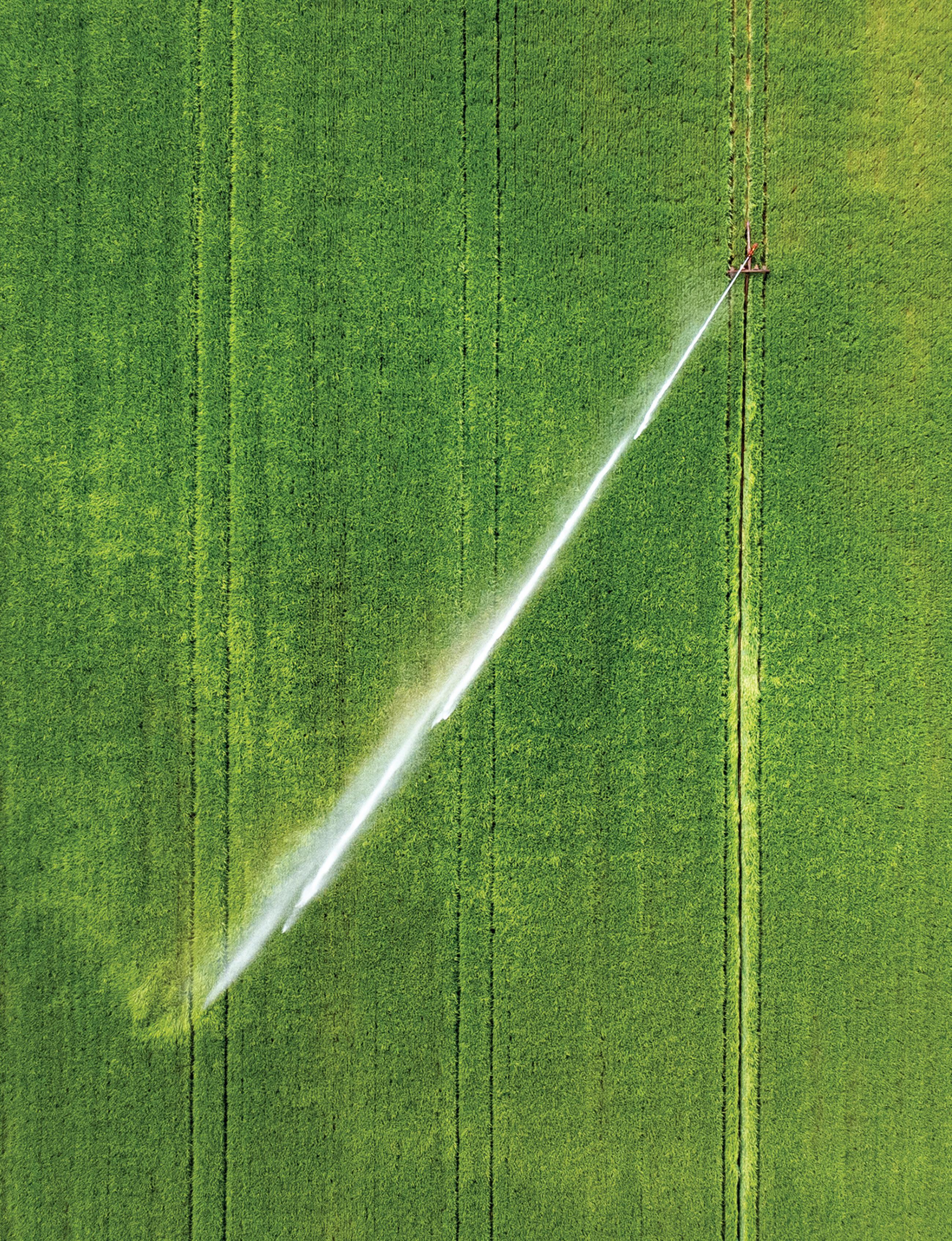
CONSERVATION & EFFICIENT WATER USE IN
Agriculture
Agriculture, vital to both Colorado’s food systems and economic health, represents the state’s most substantial water use. According to the 2023 Colorado Water Plan, over 80% of water diversions in the state are for agricultural uses. Agricultural water diversions account for about 90% of the total water consumption in the state. Consumptive use water is used in the natural cycles of evaporation and transpiration and does not return to the stream or aquifer system. Because agricultural consumptive water use is inherently linked to growing plants that produce food for people and livestock, agricultural water conservation usually results in reduced production.
Colorado agriculture now produces a market value of $9.2 billion annually, according to the 2022 National Agricultural Statistics Service Census of Agriculture. Agriculture in Colorado contributes about $47 billion annually to the state’s economy, according to the Colorado Department of Agriculture. Nearly 2.4 million acres of farmland is irrigated in Colorado, according to the U.S. Department of Agriculture’s 2023 Irrigation and Water Management Survey. That includes over 50,000 acres used to grow fruits and vegetables. Regionally produced sweet corn, melons, green vegetables, and tree fruits are summer dining highlights, while potatoes, onions, and pinto beans provide year-round sustenance. Irrigated forage and grain production enables a 3.3 million head livestock industry that is primarily dependent on 43 million acres of rainfed rangelands, according to the 2018 Colorado State University report, "Range and Pasture Management."
Irrigated agriculture accounts for 90% of the water used in the state, but only 41% of that is consumed. Yet on average, about 80% of the overall statewide agricultural diversion demand is currently met, with about 20% of demand unmet, according to the Colorado Water Plan. The water plan projects that 400,000 to 500,000 acres of irrigated land in Colorado will go out of agricultural production by 2050 due to urbanization, water transfers, and challenges with groundwater sustainability. And while climate change is projected to increase agricultural water demand, overall statewide agricultural water demand is projected to decrease as lands come out of production. This will reduce agricultural consumptive use by about a million acre-feet statewide annually, but most of this conserved water will be used by municipalities and industries. Sustaining agricultural economic productivity on reduced acreage will depend on maintaining the cultivation of high-value crops and achieving higher yields per acre — an effort that will be challenged by the increased water needs for remaining agricultural lands due to heightened evapotranspiration resulting from climate change.
By The Numbers
Optimal water use plays a role in sustaining agriculture into the future. The Colorado Water Plan calls for Coloradans to maintain the value of agriculture by investing in agricultural innovation and supporting producer adaptation to water supply constraints. Strategies for producers coping with increasing aridity and less available water may include transitioning to high-value or less-waterintensive crops, on-farm irrigation efficiency improvements, and soil health improvements which can help stretch water supplies. Producers in groundwater-dependent regions and areas where water is highly constrained are actively taking agriculture out of production to conserve and stabilize groundwater levels.
CONSERVATION VS. EFFICIENCY
In agriculture, efficiency and conservation have distinctly different meanings, and should be understood in terms of the scale at which they are applied. At the scale of a farmer’s field or pasture, conservation is the reduction of crop consumptive use. Improved irrigation efficiency results in the optimization of water use to meet crop needs with minimal excess water diversion. Efficiency ensures that reduced water withdrawals maximize both in-field benefits and downstream availability.
Number of millions of acres of farmland irrigated in Colorado
Crop consumptive use is the amount of water that permanently exits the watershed because it has been evaporated from the field surface or transpired by plants. Since crops rely on water for growth, reducing the amount of water used in farming usually leads to less water available for the plants to grow. This is because the process where plants use water, called evapotranspiration (ET), is directly connected to how much they can produce. So, when water is conserved by reducing irrigation for the same type and area of crops, it often results in lower crop yields. This, in turn, typically reduces the farm’s total income. Reducing the water that a corn or alfalfa field consumes, for example, results in less corn or alfalfa. Agricultural water conservation can also result when farmers change to less water-intensive cropping systems or withhold irrigation on their fields. These practices also generally reduce overall yields and farm income, while weeds may proliferate in unirrigated fields.
Conservation is usually accompanied by a reduced water diversion, leaving water in the river or aquifer for other uses. Conserved water is often leased or sold through a change in water rights. Unless it's designated to remain in the river through an instream flow water right, conserved water may be diverted by downstream users, potentially reducing river flows. Farmers are generally reluctant to conserve water without transferring the right,
as it may weaken their future claims to the water under the prior appropriation doctrine (see WEco’s Guide to Colorado Water Law) Agricultural water efficiency is the ratio of water consumed by a crop relative to the amount of water used to irrigate that crop. Improved irrigation efficiency results from reducing water delivery and irrigation amounts without reducing yields. This is accomplished by decreasing onfarm water seepage or runoff losses, and also losses in canal and ditch delivery systems. For the farmer, the goal is to maintain the crop water use rate and yield while reducing water losses.
Increased efficiency in water applications and delivery can result in irrigators diverting less water. When water isn’t diverted, the river ecosystem and downstream water users may benefit. However, the farmer does not gain the ability to sell or lease unused water due to efficiency improvements because the water right is measured by the historical consumptive use of the crop itself. Increased efficiency will, on a district or basin scale, impact return flow timing and amounts.
Improved irrigation efficiency may lead to increased consumptive use. Much of the irrigated land in Colorado does not receive enough irrigation water to maximize consumptive use and crop yield in all years. Within an irrigated field, there is always some variation in the amount of water applied, often a portion of the crop is over-irrigated resulting in water losses, while other portions are under-irrigated resulting in reduced consumptive use. If irrigation practices are improved to increase uniformity, this often results in less of the field being over-irrigated, reduced losses, and higher efficiency, but also more of the field receiving its full crop water requirement and increased overall consumptive use and crop yield.
SAVED WATER
'Saved water' specifically refers to reductions in historical diversions achieved through improved irrigation efficiency, allowing this water to stay within its source rather than being diverted initially. This water may percolate into the ground to recharge aquifers or return to the stream through surface channels. Colorado water courts have determined that saved water resulting from reduced losses, can't be transferred to another location or user.
RETURN FLOWS
In most irrigation systems, crops consume only part of the diverted water; the remainder returns to the water system as return flow.
In much of Colorado, return flows are diverted and subsequently returned to the river and alluvial aquifers three to seven times or more before exiting the state. Water users downstream depend on return flows to fulfill their water rights. Therefore, when an agricultural water right is sold, only the historical consumptive use of the original water right can be transferred to another user. The transfer must maintain historical return flow volume and timing and prevent injury to other water users.
By reusing irrigation return flows, a basin’s water use efficiencies may be much higher than those of an individual field. For example, although the delivery and on-farm irrigation efficiency in the South Platte Basin may be 30% to 70%, the basin efficiency is greater than 90%. Thus, water conservation in a basin does not result when irrigation efficiency is increased for a given farm or irrigation
district. This concept of reusing return flows is important when proposing water conservation practices and estimating the benefits of irrigation efficiency improvements.
The reuse of return flows by downstream users does not imply that individual irrigators don’t need to be efficient in their operations. Not all irrigation water lost comes back to the river as a return flow. Return flows can create high water tables in some places. This results in water that is lost through evaporation and transpiration of riparian and wetland vegetation, resulting in less usable water downstream.
Return flows can also create water quality problems. Irrigation runoff can potentially pick up salts, fertilizers, pesticides and sediments and carry these constituents into rivers and shallow groundwater. Improved irrigation efficiency can reduce the movement of such constituents from fields to rivers and groundwater.
Return flows are not the same as surface runoff from agricultural fields. Runoff from fields can be reused on the farm and doesn’t become a return flow until it leaves the farm.
Carriage water, also called push water, is the additional water needed in ditch laterals to fill the ditch and “push” the water with enough head to distribute it to the farm turnouts. This carriage water is considered return flow when it percolates into the ground or is returned to the stream system through drainage ditches.
SALVAGED WATER
Plants that grow on the banks of rivers, canals and drainage ditches or in seepage areas with shallow groundwater, consume and transpire water that originated from those sources. Although removal of these plants may reduce consumptive use, this “salvaged” water cannot be converted to a water right. Riparian and wetland plants enhance aesthetics and provide environmental and recreational benefits. A 2024 study “Beneficial inefficiencies of Western ranching,” published in the journal Agriculture, Ecosystems and Environment, found that while flood-irrigated grass hay meadows in the West account for only 2.5% of the region’s irrigated footprint, they provide 58% of temporary wetland habitat. The Colorado Supreme Court has ruled that any salvaged water belongs to the watershed, not the individual who reduces non-crop consumptive use.
BEST PRACTICES FOR INCREASED EFFICIENCY
The potential for improved irrigation efficiency and means of becoming more efficient vary among operations. Water can be lost from delivery canals and ditches and from farm fields. Losses can be reduced by improving the conveyance and irrigation application systems or by improving management of the systems.
Improved and more efficient irrigation systems can result in increased crop consumptive use, particularly in water-short situations. This is because they are designed to increase production by distributing water uniformly and strategically to a crop, as opposed to furrow irrigation, which applies water unevenly — plants near the uphill source generally receive more water than plants in lower sections. Gains in yield generally hold as long as the entire field is converted from furrow irrigation to the more efficient system.
Recommended irrigation management practices can increase water use efficiency, as well as improve water quality by reducing
erosion and non-point source pollution from fertilizers, pesticides and herbicides. Best practices for managing agricultural irrigation include improving irrigation conveyance and delivery, improving irrigation application systems, irrigation scheduling, land leveling, conservation tillage, and soil health management.
1. Conveyance and Delivery
Improving irrigation water delivery systems is an important strategy for increasing agricultural water use efficiency. To reduce seepage and evaporation, ditch or irrigation companies can line open earthen ditches or convert them to pipelines. The Colorado Water Institute examined earthen ditches and in 2004 reported seepage rates varying from 20% to more than 50%. Results of a 10-year study conducted by the U.S. Bureau of Reclamation between 1992 and 2002 found that lining ditches or replacing them with buried pipelines can reduce seepage rates by 70% to 90%.
Effective linings for ditches include paving materials such as concrete and exposed and buried membranes made of plastic, synthetic rubber, or bentonite clay. Seepage losses can sometimes be reduced by making the ditch soils less “permeable” by removing vegetation and compacting the soils. Polyacrylamide and other polymer sealants and soil stabilizers can be applied to earthen ditches to seal ditch banks. This process also improves water quality.
Some ditch companies are adding automated controls and monitoring to their conveyance systems to reduce labor needs and better manage their deliveries. These supervisory control and data acquisition (SCADA) systems can also reduce water losses by eliminating spills that sometimes occur from ditch systems.
Converting ditches to pipelines can essentially eliminate water losses. Pipelines also enable water delivery to be more timely and efficiently managed because carriage water is no longer needed.
However, like ditch linings, pipelines are expensive to install, maintain and replace when the infrastructure fails. Conveyance system improvements reduce operation and maintenance costs for the ditch company and enable farmers to use the water more efficiently and effectively.
Although lining ditches often increases efficiency, it can alter historical return flows. During certain months, some rivers’ base flows originate primarily through irrigation canal seepage. Lining ditches can reduce flows and impact other water right holders.
2 . Irrigation Application Systems
Selecting an efficient irrigation system for a field involves considering many factors including soil properties, topography, field shape, the cost of the system versus the value of the crop grown, operation and maintenance costs, energy and pressure requirements, availability of local qualified expertise, and the system’s effects on crop yields.
Three types of irrigation systems are used for crops in Colorado — surface or gravity-flow systems, sprinklers, and drip or micro-irrigation methods. According to the U.S. Department of Agriculture’s Census of Agriculture 2023 Irrigation and Water Management Survey, about 1.29 million acres of the irrigated land in Colorado are watered with sprinkler irrigation, 1.12 million acres are irrigated with surface and gravity-flow systems, while just over 17,000 acres employ micro-irrigation methods.
• Surface Irrigation — Surface or gravity irrigation systems, such as furrow or flood methods, are the oldest and least expensive means of irrigation. Irrigators apply water from a head ditch or
Colorado Irrigation System Mix
Total Irrigated Acres: 2.4 million
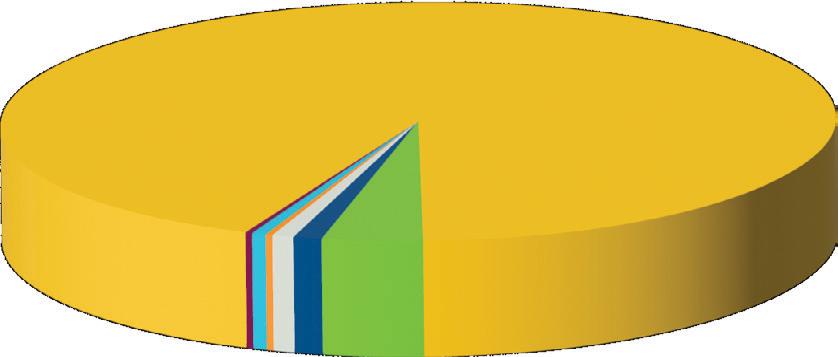
Center pivot: 1.2 million acres
Solid set and permanent sprinklers: 3,502 acres
Linear move tower sprinklers: 4,823 acres
Hand move systems: 4,178 acres
Big gun or traveler: 10,059 acres
Side roll, wheel move, or other mechanical move: 48,659 acres
Other: 17,320 acres
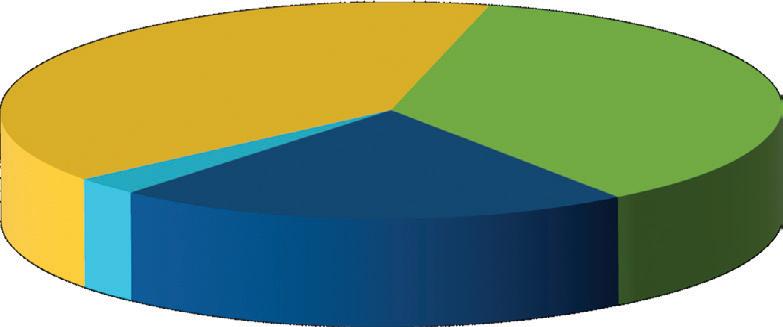
Down rows or furrows: 446,773 acres
Controlled flooding: 405,292 acres
Uncontrolled flooding: 241,026 acres
Other: 28,363 acres
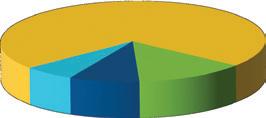
Sub-surface drip: 12,420 acres
Surface drip: 1,490 acres
Low-flow micro sprinklers: 1,079 acres
Other: 2,344 acres
SOURCE: CENSUS OF AGRICULTURE, 2023 IRRIGATION AND WATER MANAGEMENT SURVEY
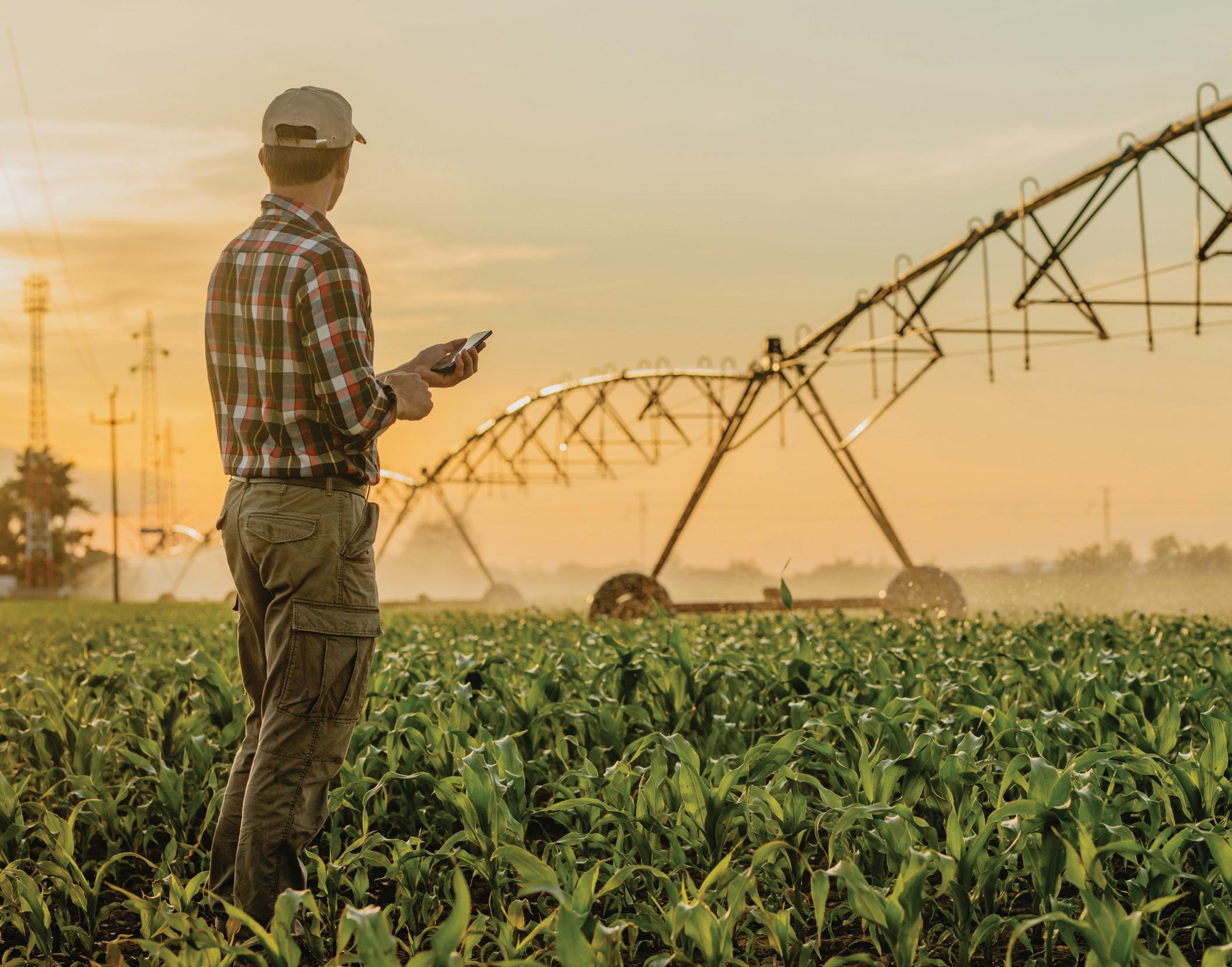
gated pipe at the upper end of the field or field section, and as the water flows across the field surface, it soaks into the soil. During each irrigation set, irrigators let the flow run all the way through the field long enough that the crops at the tail end receive water, resulting in runoff or tailwater at the lower end. During this extended period, the upper end of the field has likely received extra water that is often lost to seepage. Thus, surface irrigation management involves trade-offs between adequately irrigating the crops at the tail end and water losses to seepage and tailwater. Due to this trade-off, plus the variability in soils across a field, surface irrigation efficiency is typically in the range of 40% to 75%, with 25% to 60% of the applied water lost to seepage and tailwater runoff. Water is spread across the field by gravity, so no energy is required at the field.
The efficiency of surface, or flood and furrow, irrigation varies with soil type, field length, terrain and other factors. Precision land grading, such as laser leveling, minimizes variations in field contours and boosts the uniform distribution of surface irrigation water. A flexible water supply that can be turned on and off as required makes surface irrigation easier to manage. On flat fields, large delivery flows are often needed to achieve good efficiency. Although there have been many attempts to automate surface irrigation systems, these have generally not been successful.
Some farmers also use surge valves to improve water distribution uniformity, reduce runoff, and decrease deep percolation losses, as the intermittent flows provide better control over the irrigation set. A surge valve in furrow irrigation operates by periodically
releasing and stopping the flow of water into the furrows in controlled intervals, creating a pulsating or “surging” effect. During each surge, water quickly moves partway down the furrow, then infiltrates the soil as the flow temporarily stops. When the valve opens for the next surge, the wetted soil from the previous surge helps the water advance more effectively with reduced infiltration losses at the upper end of the furrow.
• Overhead Sprinkler Irrigation — Sprinkler irrigation systems are more efficient than surface irrigation, and more versatile, but usually more costly, especially when converting an existing surface irrigation system to sprinklers. In addition to the capital investment in the sprinkler system, irrigators pay the energy cost of pumping water to pressurize the system. Over 90% of sprinkler irrigation systems in Colorado are center pivots, the large rotating pipelines on wheels that irrigate circular fields. The U.S. Department of Agriculture's (USDA) Conservation Stewardship Program priced center pivot systems in 2023 at some $80 to $200 per acre — per-acre costs are higher for smaller and irregular fields. Certain programs like the Natural Resources Conservation Services Environmental Quality Incentives Program (EQIP) offer support for sprinkler purchases. Center pivot systems are most effective and efficient on large square fields such as quarter sections of land that are 1/2 mile on each side. Because center pivots irrigate circular areas, they only irrigate 80% of a square field. However, some irrigators have linear move systems, which can be moved and work in a straight line across rectangular fields. Both overhead sprinkler systems can be adapted to a wide range of soils and topographies.
Overhead sprinkler irrigation is typically more efficient than surface irrigation. Recent improvements in overhead sprinkler irrigation include use of low pressure sprinklers, sprayers and bubblers, usually with pressure regulators, that hang in or near the crop canopy a few feet above the ground, and electronic controllers that allow remote monitoring and control. These sprinklers are typically 70% to 90% efficient, depending on maintenance and management. Because sprinkler systems can apply water more uniformly, they often boost crop yields and save labor costs.
Side-roll irrigation systems are a type of mechanical-move sprinkler commonly used for irrigating pastures, hay fields, and certain row crops. They consist of a long pipe with attached wheels, allowing the system to be rolled from one position to another. Water is delivered through the main pipe and sprayed onto crops via rotating sprinkler heads positioned along the length of the system. Typically moved manually or with a small motor, side-roll systems offer efficient water distribution, though they require relatively flat terrain and manual labor to reposition. This setup provides flexibility in water application and can cover large areas with moderate water pressure. About 4% of all sprinkler-irrigated acres in Colorado rely on mechanical-move systems.
• Micro-Irrigation — Micro-irrigation systems are the most efficient because they deliver water at a slow, frequent and consistent rate directly to the soil near the plant’s roots, ensuring that little water is lost. The precision of these systems creates prime growing conditions that are ideal for high-value crops such as fruits and vegetables. Examples of micro-irrigation include surface drip, sub-surface drip, and micro-sprayers. Although they’re efficient, micro-irrigation systems are very expensive, at $100-$430 per acre, according to 2023 numbers from the USDA. Efficiency of microirrigation systems is typically over 80% and may be as high as 95%. As of 2023, 17,333 acres on 873 farms in Colorado were irrigated with micro-irrigation systems. More than 70% of those micro-irrigated acres relied on sub-surface drip systems.
3. Irrigation Scheduling
Irrigators can enhance on-farm water efficiency by scheduling irrigation based on soil moisture and plant evapotranspiration (ET) rates. Ideally, irrigators should apply the right amount of water at the right time to maintain optimal plant growth. Good irrigation scheduling can improve water efficiency by at least 20%, according to research by Colorado State University. In some cases, the ability to schedule irrigation to meet crop needs is limited by the capability of the ditch company to deliver water when needed. Many ditch companies deliver water on a fixed rotation and are limited by the available river supply and their water right priority. Farmers who pump groundwater have more flexibility with irrigation scheduling.
• Soil Moisture Monitoring — Monitoring soil moisture levels to determine when and how much to irrigate can improve irrigation scheduling while also boosting crop yields. Determining soil moisture can be as simple as feeling the soil or as sophisticated as using cloudbased telemetry to download data remotely from moisture sensors or to analyze data collected by drones.
Soil moisture sensors placed at various locations within a field collect continuous, point-specific data on soil water content. This data serves as a ground truth reference, which can verify
measurements taken across an entire field by a drone, or UAV (unmanned aerial vehicle). UAVs equipped with multispectral or thermal sensors capture surface moisture variability over large areas, and these aerial images can be used to build spatial moisture maps. These comprehensive visualizations can help identify patterns, track changes and optimize irrigation across the field by addressing variable water needs based on precise, localized data.
Artificial Intelligence (AI) and machine learning (ML) can play a transformative role in processing and analyzing the combined data from in-field soil moisture sensors, UAV imagery, and spatial mapping methods to create optimized, data-driven irrigation prescriptions. Machine learning algorithms can analyze patterns and correlations in soil moisture, crop type, weather data, and historical irrigation practices, learning how different factors impact water needs at various growth stages. By integrating these data streams, AI can predict moisture requirements across different areas of a field and provide targeted irrigation recommendations based on real-time conditions and forecasted crop demand. In essence, AI streamlines the process of transforming complex data into actionable insights for precision irrigation, promoting efficient water use and healthier crop yields.
Soil moisture sensors come in several types with varying levels of expense, each with unique methods for measuring moisture levels. Time Domain Reflectometry (TDR) sensors measure soil moisture by sending an electrical pulse through the soil and analyzing the time it takes to return, which varies with the soil’s water content. Tensiometers measure soil water tension, or the energy required by plants to extract water from the soil, making them effective for monitoring moisture in relatively wet soils but less accurate in dry conditions. Capacitance sensors, on the other hand, use the soil’s dielectric constant to estimate moisture levels by measuring changes in the sensor’s electrical capacitance. These sensors are quick to respond and can be used across a range of soil moisture conditions. Together, these tools provide farmers and researchers with valuable data for making informed irrigation decisions tailored to specific soil types and crop needs.
The least expensive method of soil moisture monitoring is through direct inspection — collecting and inspecting or weighing soil cores.
More sophisticated sensors are increasingly being used: portable sensing tools can be pushed or augered directly into the soil, while other systems rely on buried sensors that connect to a device for tracking soil moisture data. Sophisticated systems employ telemetry to transmit readings from sensors buried in the field to data loggers or cloud-based servers that can be accessed from a computer or mobile device.
• CoAgMET — The Colorado Agricultural Meteorological Network is a network of nearly 100 automatic weather stations located primarily in agricultural areas that publish daily reference evapotranspiration values. Data is available at https://coagmet.colostate.edu. CoAgMET data-collection stations are managed by the Colorado Climate Center at Colorado State University. This data offers potential ET, which represents the ideal water demand of crops under optimal growing conditions. However, to achieve this ideal ET rate, irrigators must account for the inefficiencies and losses in their irrigation systems. CoAgMET reports include ET estimates for 14 popular crops and fruit trees, as well as cool season turf, which irrigators can use to refine irrigation schedules or integrate into their own scheduling methods for improved timing and water application.
• Water Irrigation Scheduler for Efficient Application — An online tool, the Water Irrigation Scheduler for Efficient Application, or WISE, available at https://erams.com/catena/tools/agriculturalresources/irrigation-advisor, uses CoAgMET data and information from farmers to estimate daily soil water additions and depletions which can indicate the required amount and timing of irrigation.
• Remote Sensing by Satellite or Drone — Irrigators can also use remote sensing or captured images from a satellite or drone to track the water use and needs of crops as well as to provide other information on crop health. Remotely-sensed multispectral imagery with visible, near-infrared, and thermal wavebands can be used to estimate the ET rate within each field area, which can then determine irrigation water requirements and spatial differences between stressed and non-stressed crops.
• Scheduling Systems — The most accurate irrigation scheduling combines in-field monitoring with remote sensing. Several companies are developing AI-based irrigation scheduling systems that collect data from various sources. Crop consultants use such systems to create irrigation schedules. Schedules can be paired with electronic irrigation controllers to automate irrigation.
4. Conservation Tillage and Soil Health Management
An important approach to maximize total water use efficiency is to fully utilize precipitation. This requires insuring as much precipitation as possible is available for crop water use by considering past and forecast rainfall in the irrigation schedule and by using conservation tillage to ensure that rainfall is stored in the soil. Conservation tillage refers to any cultivation method that leaves at least 30% of the soil surface covered by crop residue or stubble. By maintaining more ground cover and disturbing less soil than traditional cultivation methods, conservation tillage and no-till techniques reduce runoff by holding snow and rainfall on the field, decrease surface evaporation, promote soil moisture retention, and minimize soil compaction. These methods and other practices boost soil health and increase soil organic matter (SOM). According to the Colorado Department of Agriculture, for each 1% increase in SOM, the soil’s ability to hold water increases by 3.7%.
AGRICULTURAL WATER CONSERVATION IN PRACTICE
Agricultural water conservation results from reduced consumptive use throughout the process of diverting, storing, delivering, irrigating and returning water to the river or aquifer. Conserved water can be used for other beneficial uses. Reduced consumptive use may or may not provide benefits for the water rights holder. The primary opportunities for consumptive use savings are by reducing the area irrigated or reducing consumptive use on irrigated fields.
1. Fallowing
The most common conservation strategy is to reduce the amount of irrigated land. This can result from a permanent change from irrigated to unirrigated land, or the rotational fallowing of irrigated fields. Permanent change allows the water right to be permanently transferred to other users — primarily sale to urban or industrial
uses, commonly referred to as “buy and dry.” The 2019 Technical Update to the Colorado Water Plan estimates that between 150,000 to 300,000 acres of irrigated farmland will be fallowed due to ag to municipal and industrial water transfers between now and 2050 and about 200,000 additional acres will be fallowed for other reasons such as to meet interstate compact requirements or environmental water needs. Temporary fallowing can result from inadequate water supply to irrigate in dry years, temporary water trading among farmers on a ditch system, or temporary transfers of the water to other uses such as through collaborative water sharing agreements.
Fallowed or unirrigated land may be left bare, returned to native vegetation, temporarily cover cropped, or converted to other uses. Land left bare is subject to water and wind erosion and weed infestation and is not recommended. In Colorado, fields that are not irrigated may also experience increased soil salinity as natural evaporation draws salts from deeper soil layers to the surface, concentrating them in the root zone and potentially impacting crop health. Several recent projects have shown that most irrigated lands can be returned to native grassland vegetation, although the process is expensive and requires several years. Cover crops such as small grains that survive under rainfed conditions can be planted on rotationally fallowed land to reduce erosion and control weeds. Sometimes irrigated farmland is converted to urban landscapes as cities expand over previously irrigated land.
Fallowing irrigated land does not eliminate consumptive use — most of the precipitation that falls on unirrigated land is evaporated or transpired by vegetation. On most of the irrigated land in Colorado, 25% to 50% of the consumptive use originates from rainfall. Fallowing eliminates just the portion of consumptive use that originates from water diverted for irrigation. Only the consumptive use portion of irrigation water can be transferred to other uses.
2 . Limited or Deficit Irrigation
A second way to conserve agricultural water is to reduce consumptive use on irrigated fields. This can be accomplished by changing from water-intensive crops to low-water-use crops, or by deficit irrigating crops. Farmers may plant low-water-use or drought tolerant crops when their water supply is inadequate due to lowpriority water rights, declining groundwater, or low snowpack or reservoir storage. Many Colorado farmers have experience farming with inadequate irrigation water supply and with rainfed agriculture.
The terms limited irrigation and deficit irrigation both refer to strategies for managing water under scarcity, but they differ in approach and intent:
Limited Irrigation generally refers to reducing the total volume of water applied over the entire farm or throughout the growing season. It may involve applying less water overall, but not necessarily at the expense of any specific crop’s water needs. The goal is often to conserve water across the whole farm. Limited irrigation can mean strategically irrigating at certain growth stages or using a rotational approach to distribute water among crops without systematically under-irrigating any one area.
Deficit Irrigation is a more targeted strategy where water is applied below the full crop water requirements, deliberately creating a water deficit. This approach is often used when water supplies are limited, so irrigators prioritize water application during critical growth stages, accepting reduced yields as a trade-off for using less water.
Aligning with the concept of deficit irrigation is water-supplylimited irrigation. In water-supply-limited irrigation, the amount of
water available is insufficient to meet the crop’s full ET requirements throughout the season. Irrigators manage this limited water supply by applying it strategically, often at critical growth stages, to mitigate yield reductions as much as possible. This approach accepts that the crop will not receive its full water needs, and involves intentionally underirrigating based on the constraints of available water.
A typical strategy to reduce water use is to change from long-season summer crops such as corn or alfalfa, to shorter season crops such as small grains or beans and other legumes. Because small grains, such as wheat, mature by midsummer, they require less irrigation water. Likewise, the growing season for beans is typically 25% shorter than corn and thus beans require less irrigation water. Some crops such as sorghum, millet and sunflower are drought tolerant and produce yields with limited irrigation water, although these crops typically produce less income than traditional irrigated crops. High value short-season replacement crops such as leafy vegetables can sustain farm income while consuming less water although these crops may have limited markets. A positive aspect of agricultural water productivity is that yields of some major irrigated crops such as corn have increased about 2% per year while water use per acre has remained constant due to improved varieties and management, according to the National Agricultural Statistics Service Census.
By The Numbers
deficit irrigation will reduce consumptive use, because irrigation efficiency is also increased and return flows decreased, the consumptive use savings is generally smaller than the irrigation application reduction. It is difficult to create consumptive use savings that can be transferred to other users with deficit irrigation due to the complex monitoring required to document the savings.
A concern with deficit irrigation is, because of reduced water seepage, salts that naturally occur in all irrigation water can accumulate in the soil. The salts will eventually make the soil unproductive without occasional intense rainfall or excess irrigation to leach salts below the crop rooting depth.
How much shorter the growing season is for beans than corn — meaning they require less irrigation water
A common method to reduce farm field consumptive use is to reduce the non-beneficial evaporation losses from the soil or non-crop plants. Good weed control reduces consumptive use by non-crop plants. Reduced tillage and surface residue reduce soil evaporation. Reduced irrigation frequency reduces soil wetting and soil evaporation. A large portion of off-season or pre-plant irrigation is lost to soil evaporation. Localized soil wetting with drip irrigation reduces soil evaporation and may reduce seasonal consumptive use by 10% or 20%. Once the crop has grown and most of the ground is shaded, soil evaporation and thus potential savings are small. Soil evaporation is difficult to measure and document, so farmers can seldom gain consumptive use saving credit for these management practices. However, they are useful to stretch water and boost crop yields during drought periods or for perennially water-short farms.
Regulated deficit irrigation (RDI) is a strategic approach that reduces water application only during growth stages when crops are less sensitive to water stress, minimizing yield impacts and sometimes even enhancing crop quality. In contrast, simply deficit irrigating applies less water than the crop requires throughout the season, causing chronic water stress that typically reduces yields and is generally undesirable. For example, USDA studies in eastern Colorado have shown that corn is less vulnerable during early vegetative growth and final maturation than during reproductive and grain fill stages. Likewise, small deficits tend to cause relatively less yield loss than large deficits. CSU research in western Colorado has shown that alfalfa can survive deficits during the highest consumptive use periods in mid-summer and still produce acceptable spring and fall cutting yields. Many university agronomists and seed companies are working to develop crop varieties that maintain acceptable yields with less water, although reduced yield is usually associated with reduced consumptive use. These “drought tolerant” varieties are most beneficial when unplanned deficits occur. Although deficit irrigation will usually reduce yield and farm gross income, net income loss can be minimized by adjusting crop inputs, such as fertilizer and seeding rate, that are appropriate for the expected reduced yield. This is a common practice with rainfed production. When done intentionally, the farmer’s goal of deficit irrigation is usually to minimize the economic costs of an inadequate water supply, while the water conservation goal would be to reduce consumptive use while maintaining economic viability. Although
Soil evaporation and non-crop transpiration also occur on the banks of ditch conveyance systems and tailwater drainage ditches. Thus ditch maintenance, lining and conversion to pipelines can reduce non-beneficial consumptive use and conserve water for other uses. However, this ditch bank and riparian vegetation also provides greenbelts and habitat that are valued by society and wildlife and can be considered a beneficial use. Current state water law does not allow this type of reduced consumptive use to be converted to water rights credits and transferred other beneficial uses.
INCENTIVES AND DISINCENTIVES FOR WATER CONSERVATION
For a farmer, the primary incentive to conserve water is adequate payment for the conserved water. If conserved water can be sold or leased to another user, the water transfer may provide more income than growing a crop. There are transaction costs involved in changing water rights to a new use or location including engineering calculations of saved consumptive use, legal costs, conveyance costs to deliver the water to the new user, and possibly costs to mitigate environmental effects of fallowing land. Thus, the farmer does not reap the full value of the water. It is also common to pay farmers to fallow irrigated land to meet interstate compact requirements. Current programs in the Colorado River Basin, the Republican River Basin, and the Rio Grande Basin, funded by regional, state and federal programs, pay farmers to permanently or temporarily fallow irrigated land. In 2024, temporary land fallowing was being purchased in the Colorado River Basin for $509 per acre-foot of saved water per year. The U.S. Department of Agriculture’s Conservation Reserve Enhancement Program pays farmers for every acre that goes unirrigated. To qualify, land must be put to grass for at least 15 years and the water right permanently retired. After 15 years, the land can be turned to dryland farming.
Colorado has also been promoting collaborative water sharing agreements (previously referred to as alternative transfer methods, ATMs, or interruptible supply agreements) as a way to temporarily meet water needs. Under these agreements, water can be leased between parties while avoiding permanent water transfers. The purpose is to reduce water shortage risks to municipal, industrial, environmental and recreational water uses without permanently reducing irrigation and impacting rural economies.
A disincentive of water conservation without a water right transfer is that the quantity of the water right is diminished when consumptive use is reduced. Water rights are based on historical consumptive use – usually the average over the previous 50 years. If consumptive use is reduced, either by reducing the area irrigated, deficit irrigation, or other measures, without protecting the water right, the future quantity of the right will be reduced.
A disincentive of water conservation resulting in water rights transfers is that the rural agricultural economy from which the water is transferred will likely suffer. This has occurred in areas with agricultural to municipal water transfers.
A disincentive of land fallowing is that previously irrigated land does not naturally return to an unirrigated ecosystem and is vulnerable to erosion and weed infestation. Successful reestablishment of native grassland vegetation requires several years of investment and careful management.
INCENTIVES FOR EFFICIENT WATER USE IN AGRICULTURE
A variety of incentives are available to encourage more waterefficient irrigation equipment and management. Some incentives are economic, including reduced energy and pumping costs, time savings associated with less labor-intensive systems, and potential increases in crop yields. Other incentives include improved water quality, storage of water in reservoirs for release when it is most needed, or preservation of water in deep aquifers for future generations. There are also a variety of incentive programs available to help offset the cost of efficiency improvements.
1. Economic Incentives
When deciding whether to invest in an improved irrigation system, irrigators must determine if the investment can pay for itself within a reasonable timeframe.
Irrigators can see substantial reductions in energy costs, as well as reduced evaporative water loss and increased crop yields, after converting from high- to low-pressure sprinkler systems. This conversion can result in a 40% reduction in energy costs; however, the pump, motor and sprinklers all must be modified for the reduced operating pressure to realize the savings.
Growers have also seen yield increases after installing more efficient irrigation systems. For example, irrigators in the Arkansas Valley who switched to drip irrigation methods for melon and vegetable crops have noted marked increases in fruit quality and yields. More efficient systems usually apply water more uniformly to the field resulting in more uniform crop yields.
Updated irrigation technology can also lead to labor savings. A primary reason farmers change from surface to center pivot irrigation is to save labor. One irrigator can irrigate a few hundred
acres of surface irrigation or manage a few thousand acres of center pivot systems. Automated canal gates and controls can reduce ditch company labor needs while reducing tail end spills and provide more flexibility to deliver water when needed.
2 . Financial Assistance and Cost-Share Programs
Agricultural producers who want to improve the efficiency of their irrigation systems may be able to access technical and financial assistance from a variety of resources including local, state and federal agencies, universities, nonprofits and private companies.
For Colorado farmers and ranchers, the most extensive federal source of technical and financial assistance is the Natural Resources Conservation Service, or NRCS, a branch of the U.S. Department of Agriculture. NRCS programs offer assistance to address a variety of natural resource concerns, including water quality, water use efficiency, soil quality, and soil erosion.
One of the best-known NRCS programs is the Environmental Quality Incentive Program, or EQIP. This program offers technical and financial help for implementing agricultural water conservation and efficiency practices and for developing general soil conservation plans. A conservation program initiated in the 2018 Farm Bill is Conservation Innovation Grants (CIG) to test innovative conservation methods on agricultural lands.
Through the 2018 Farm Bill, the USDA extended the Regional Conservation Partnership Program (RCPP). The RCPP offers grants promoting a collaborative approach to regional conservation. Partnerships can include agricultural districts, sportsmen’s groups, water providers, nonprofits, universities, businesses and others.
Nonprofits are also connecting irrigators with one another and to RCPP funding, while encouraging more efficient water use. Groups like The Nature Conservancy, Trout Unlimited, the Colorado Agricultural Water Alliance, the Environmental Defense Fund, and Western Resource Advocates work on joint and separate efforts to provide guidance, share resources, and develop policy around agricultural water conservation.
The U.S. Bureau of Reclamation also offers a WaterSMART program that has a variety of grants available to assist applicants with agricultural water efficiency improvements. Reclamation also makes funding available through the Colorado Water Conservation Board (CWCB) and local NRCS offices as part of the Upper Colorado River Salinity Control Program. This funding supports salinity control projects in four river basins in Colorado — the Gunnison, Dolores, Colorado, and San Juan. Through the program, landowners receive assistance for water efficiency improvements in order to reduce water seepage losses and the amount of salts entering the Colorado River.
State funding is also available. The CWCB offers an Alternative Agricultural Water Transfer Methods grant program, which not only funds efforts to look at the mechanics of interruptible water supply agreements between farmers and municipalities, but also supports the implementation of alternative cropping patterns and limited irrigation. Locally, additional resources and opportunities are often available through Colorado State University’s extension offices.
3. Water Quality Improvement
The U.S. Environmental Protection Agency has determined that four of the top six causes of water quality impairment in the United States are associated with agricultural runoff. Improved irrigation efficiency often leads to water quality improvements because the transport of fertilizer, nutrients, pesticides and sediment into the
groundwater or nearby streams is reduced in conjunction with the reduction in runoff and water loss to deep percolation.
4. Education and Technical Assistance
Colorado State University including extension offices, water conservancy districts, irrigation and ditch companies, agricultural and environmental organizations, and others offer a variety of educational materials, training workshops, and field demonstration projects to help improve agricultural water use efficiency. Some agencies also offer incentives such as free installation of soil moisture monitoring devices or on-site technical consultations.
Conservation districts work collaboratively with NRCS offices supporting programs to help farmers improve irrigation systems and the environment. Nonprofits also offer resources, and the Agricultural Water Conservation Clearinghouse provides online resources that promote improved irrigation efficiency.
CHALLENGES TO EFFICIENT WATER USE IN AGRICULTURE
The primary challenge for farmers wishing to improve their irrigation efficiency is the cost of improvements. Although there are several state and federal programs that provide cost sharing for irrigation improvements, at least part of the cost is borne by the farmer. A farmer must realize economic benefits, however, such as higher yields or reduced labor or energy costs to be motivated to improve their system or management.
Improved irrigation efficiency reduces return flows. This may impact the water rights of downstream users unless return flows are augmented by other water supplies such as reduced diversions or water releases from storage. When efficiency improvements result in increased yields, water consumption may increase and impact downstream water rights. Even when consumptive use does not increase, the timing of return flows changes. In the Yampa Basin, for example, flood irrigation in the spring recharges wetlands, natural aquifers and shallow groundwater, then boosts streamflows with return flows in late summer. Conversion to sprinkler irrigation in the Yampa Basin would result in drying up certain wetlands that rely on return flows from flood irrigation. However, careful management and augmentation could enhance wetlands while improving irrigation efficiency and downstream water quality.
Under Colorado law, if a water right has not been put to beneficial use for a period of 10 years or more, the State Engineer may list the water right on the decennial abandonment list for the water court to declare that water right abandoned. Although a water right cannot be legally considered abandoned unless the owner shows intent to abandon, non-use of the right for 10 years does make it vulnerable. Many water right holders are concerned that if efficiency improvements mean they no longer need to divert as much water, they could lose a portion of their water right permanently.
This common concern misinterprets what constitutes the measure and limit of a water right in Colorado. Say, for example, that a farmer wants to sell his or her water right to a city. As part of the required “change of use” proceeding, the water right will be quantified based on its historical consumptive use — the amount of water a given crop on a given number of acres has consumed over time. A crop’s consumptive use will not change substantially with the use of more water-efficient
irrigation techniques, and therefore the amount of water tied to an individual’s water right will also not change. Still, some water right holders incorrectly perceive that if they ever want to sell their water right or change its use, more efficient practices diverting less water may diminish the amount and value of their water right.
The Colorado Water Center and Colorado Division of Water Resources released a special report in February 2016, “How Diversion and Beneficial Use of Water Affect the Value and Measure of a Water Right: Is ‘Use It or Lose It’ an Absolute?” that helps clarify these legal questions. The report notes that diversions in excess of the amount necessary to accomplish the decreed beneficial use could be curtailed as wasteful. It also notes that, while the diversion amount is an important component of a water right, excess diversions do not add to a water right’s value in a change of water right case. Rather, in a historical consumptive use analysis, “excess diversions will either be discounted as wasteful or made a part of the return flow obligations of the applicant.”
Additional Resources
• Alliance for Water Efficiency: https://allianceforwaterefficiency.org
• American Water Works Association, G480-20 Water Conservation and Efficiency Program Operation and Management, (2021).
• Laura Belanger, Chelsea Benjamin, Lindsay Rogers, Victoria Arling, Caroline Koch, Enabling Large-Scale Transformation of Non-Essential Turf in Colorado Communities. Western Resource Advocates and WaterNow Alliance, (2025).
• Chelsea Benjamin, Lindsay Rogers, The State of Water-Wise Landscaping Standards in Colorado Western Resource Advocates, (2024).
• Colorado State University Extension: https://extension.colostate.edu
• Colorado Water Conservation Board, Colorado Water Plan, (2023).
• Colorado WaterWise: https://coloradowaterwise.org
• Colorado WaterWise, Guidebook of Best Practices for Municipal Water Conservation in Colorado, (2024).
• Diana Denwood, Amy Volckens, The State of Water Conservation in Colorado: A Review of Public Water Systems. Colorado WaterWise, (2022).
• Resource Central: https://resourcecentral.org
• Qualified Water Efficient Landscaper: https://www.qwel.net
• WaterNow Alliance: https://waternow.org
• Water Reuse Association: https://watereuse.org
• Western Resource Advocates: https://westernresourceadvocates.org
Publication of Water Education Colorado's Community Guide to Colorado Water Conservation and Efficiency, Third Edition was made possible by the generous support of the following sponsors:

